

What is Cost Assignment?
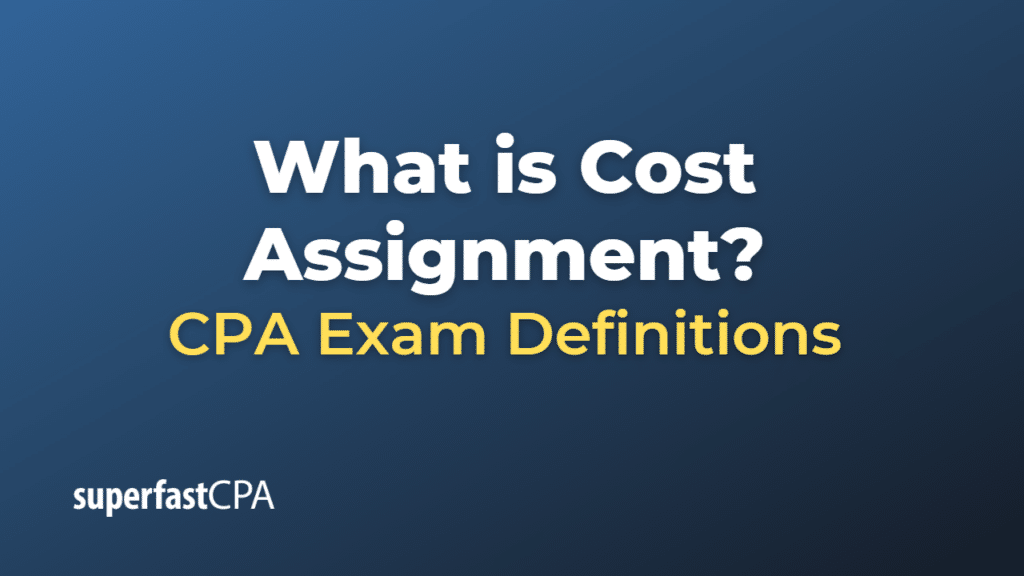
Share This...
Cost assignment.
Cost assignment is the process of associating costs with cost objects, such as products, services, departments, or projects. It encompasses the identification, measurement, and allocation of both direct and indirect costs to ensure a comprehensive understanding of the resources consumed by various cost objects within an organization. Cost assignment is a crucial aspect of cost accounting and management accounting, as it helps organizations make informed decisions about pricing, resource allocation, budgeting, and performance evaluation.
There are two main components of cost assignment:
- Direct cost assignment: Direct costs are those costs that can be specifically traced or identified with a particular cost object. Examples of direct costs include direct materials, such as raw materials used in manufacturing a product, and direct labor, such as the wages paid to workers directly involved in producing a product or providing a service. Direct cost assignment involves linking these costs directly to the relevant cost objects, typically through invoices, timesheets, or other documentation.
- Indirect cost assignment (Cost allocation): Indirect costs, also known as overhead or shared costs, are those costs that cannot be directly traced to a specific cost object or are not economically feasible to trace directly. Examples of indirect costs include rent, utilities, depreciation, insurance, and administrative expenses. Since indirect costs cannot be assigned directly to cost objects, organizations use various cost allocation methods to distribute these costs in a systematic and rational manner. Some common cost allocation methods include direct allocation, step-down allocation, reciprocal allocation, and activity-based costing (ABC).
In summary, cost assignment is the process of associating both direct and indirect costs with cost objects, such as products, services, departments, or projects. It plays a critical role in cost accounting and management accounting by providing organizations with the necessary information to make informed decisions about pricing, resource allocation, budgeting, and performance evaluation.
Example of Cost Assignment
Let’s consider an example of cost assignment at a bakery called “BreadHeaven” that produces two types of bread: white bread and whole wheat bread.
BreadHeaven incurs various direct and indirect costs to produce the bread. Here’s how the company would assign these costs to the two types of bread:
- Direct cost assignment:
Direct costs can be specifically traced to each type of bread. In this case, the direct costs include:
- Direct materials: BreadHeaven purchases flour, yeast, salt, and other ingredients required to make the bread. The cost of these ingredients can be directly traced to each type of bread.
- Direct labor: BreadHeaven employs bakers who are directly involved in making the bread. The wages paid to these bakers can be directly traced to each type of bread based on the time spent working on each bread type.
For example, if BreadHeaven spent $2,000 on direct materials and $1,500 on direct labor for white bread, and $3,000 on direct materials and $2,500 on direct labor for whole wheat bread, these costs would be directly assigned to each bread type.
- Indirect cost assignment (Cost allocation):
Indirect costs, such as rent, utilities, equipment maintenance, and administrative expenses, cannot be directly traced to each type of bread. BreadHeaven uses a cost allocation method to assign these costs to the two types of bread.
Suppose the total indirect costs for the month are $6,000. BreadHeaven decides to use the number of loaves produced as the allocation base , as it believes that indirect costs are driven by the production volume. During the month, the bakery produces 3,000 loaves of white bread and 2,000 loaves of whole wheat bread, totaling 5,000 loaves.
The allocation rate per loaf is:
Allocation Rate = Total Indirect Costs / Total Loaves Allocation Rate = $6,000 / 5,000 loaves = $1.20 per loaf
BreadHeaven allocates the indirect costs to each type of bread using the allocation rate and the number of loaves produced:
- White bread: 3,000 loaves × $1.20 per loaf = $3,600
- Whole wheat bread: 2,000 loaves × $1.20 per loaf = $2,400
After completing the cost assignment, BreadHeaven can determine the total costs for each type of bread:
- White bread: $2,000 (direct materials) + $1,500 (direct labor) + $3,600 (indirect costs) = $7,100
- Whole wheat bread: $3,000 (direct materials) + $2,500 (direct labor) + $2,400 (indirect costs) = $7,900
By assigning both direct and indirect costs to each type of bread, BreadHeaven gains a better understanding of the full cost of producing each bread type, which can inform pricing decisions, resource allocation, and performance evaluation.
Other Posts You'll Like...
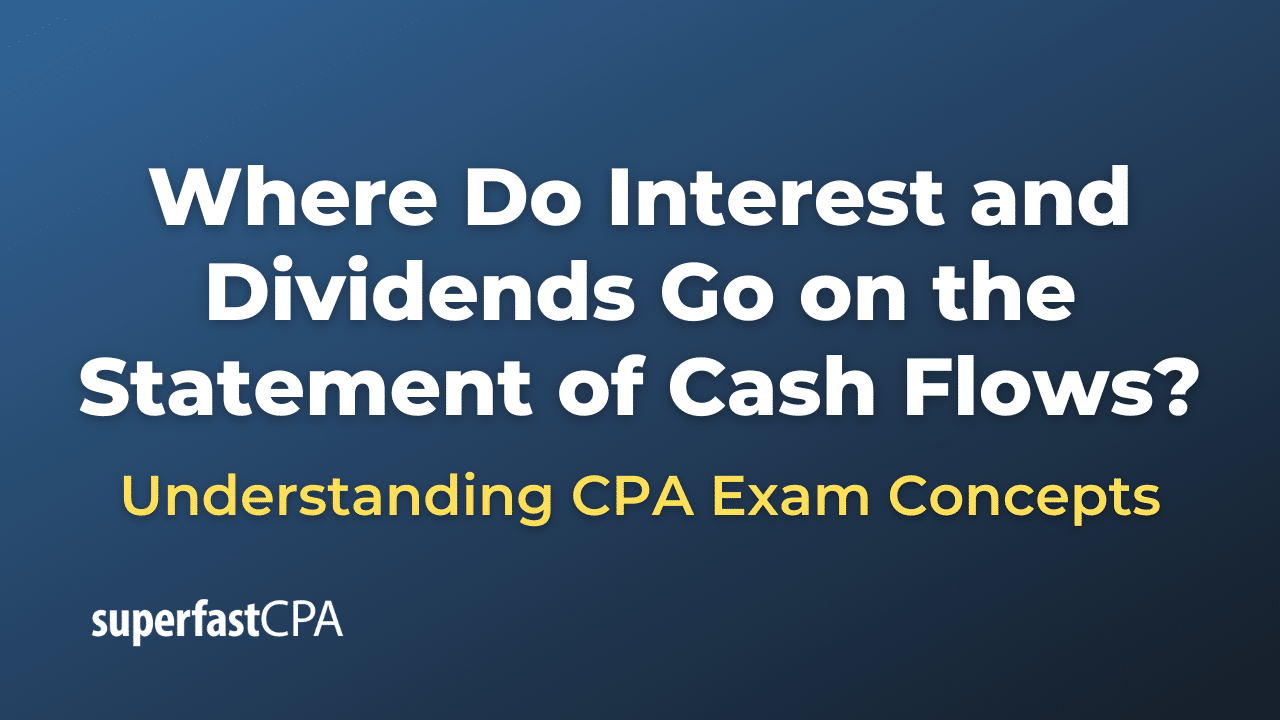
Where Do Interest and Dividends Go on the Statement of Cash Flows?
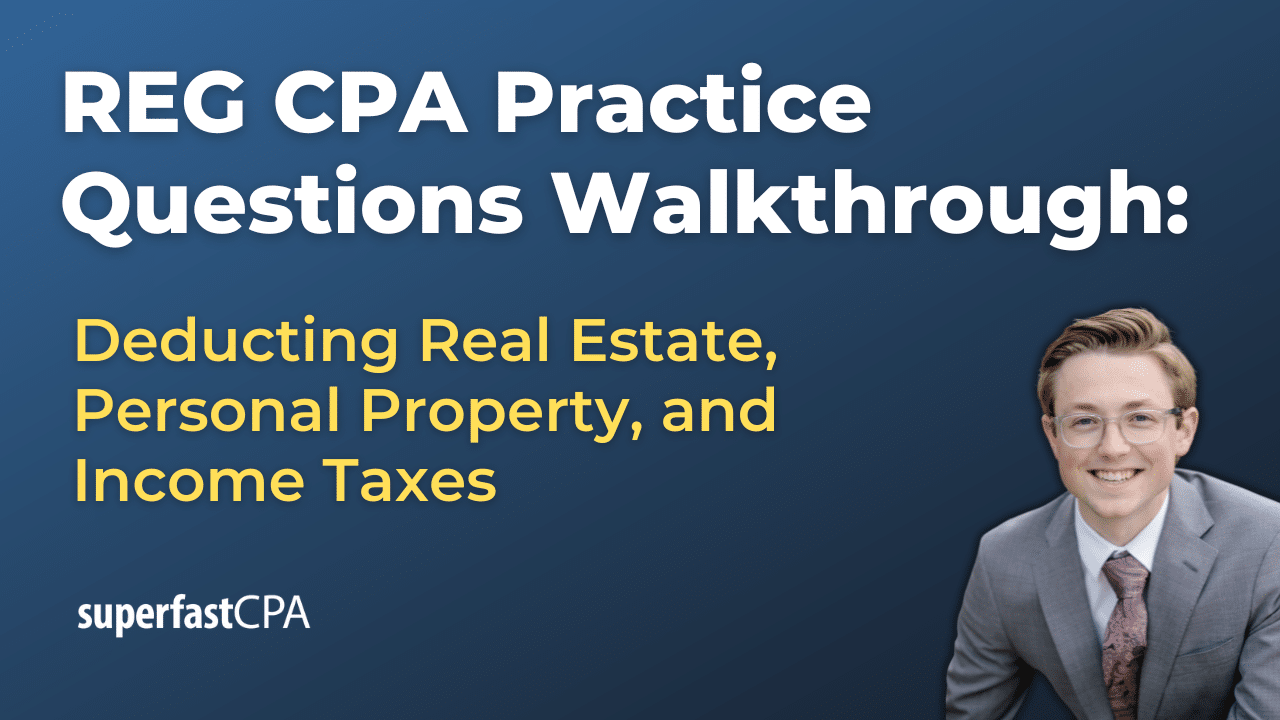
REG CPA Practice Questions Explained: How to Deduct Real Estate and Other Taxes
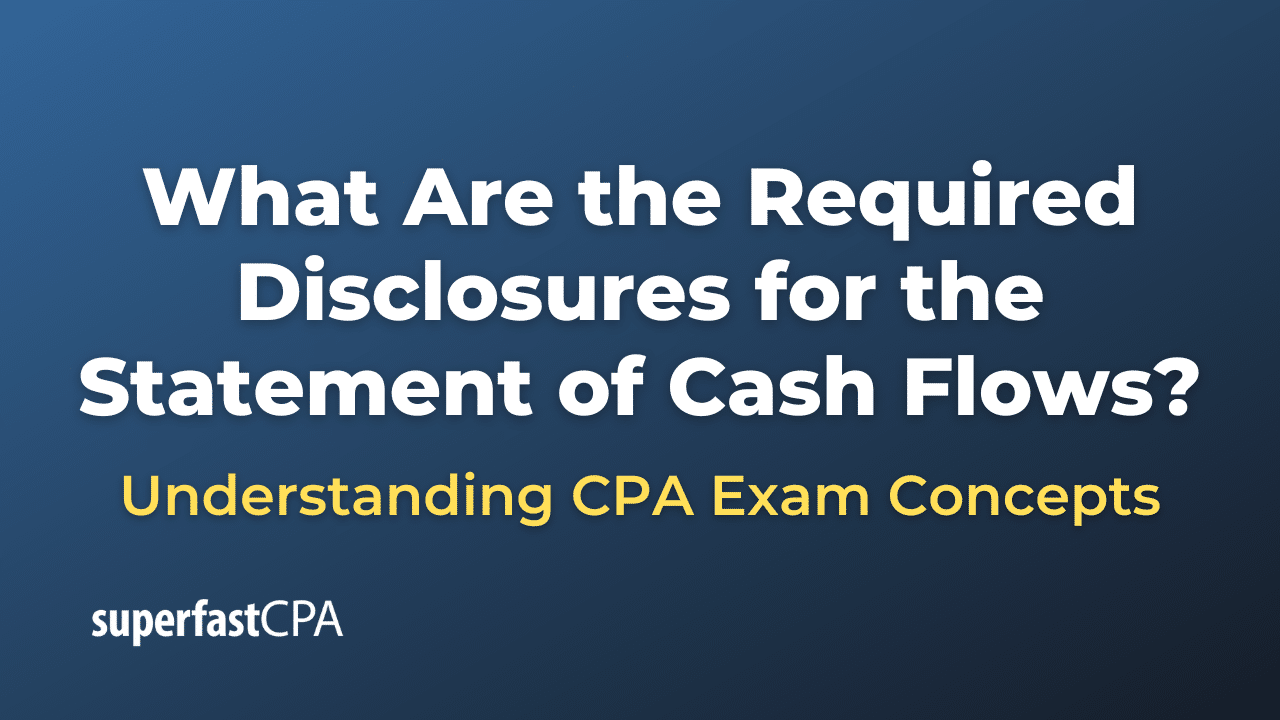
What Are the Required Disclosures for the Statement of Cash Flows?
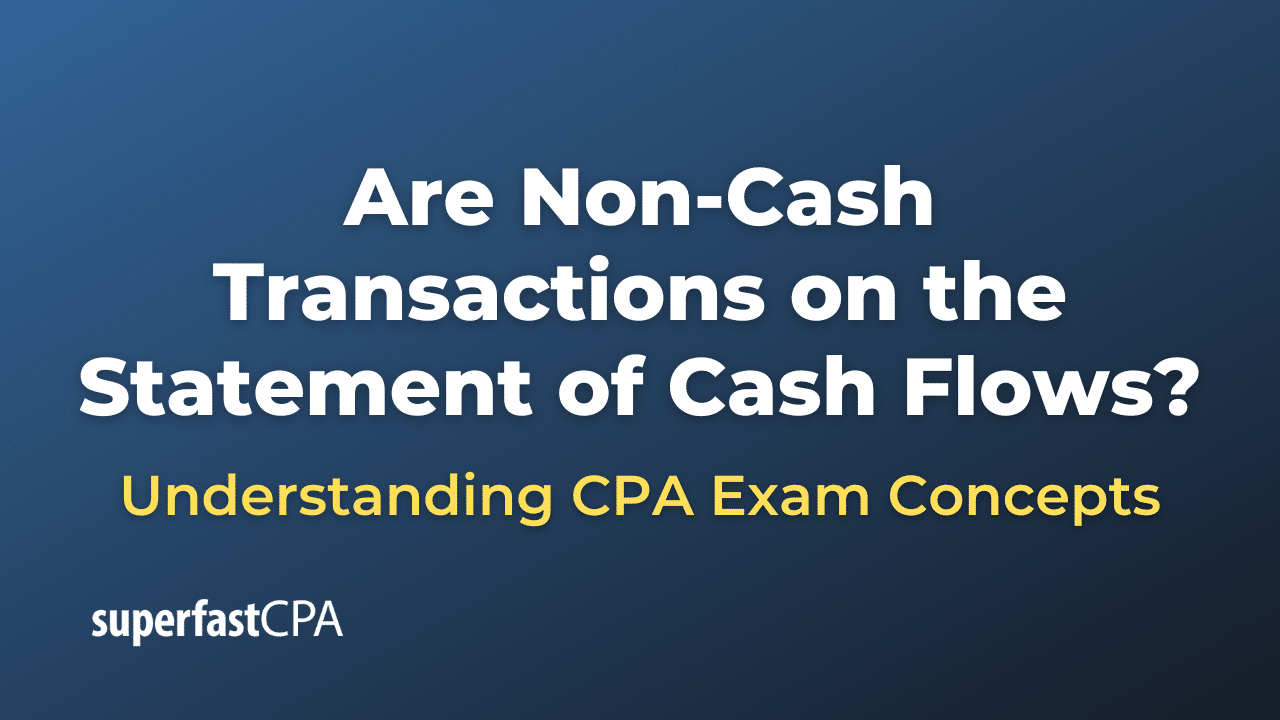
Are Non-Cash Transactions on the Statement of Cash Flows?
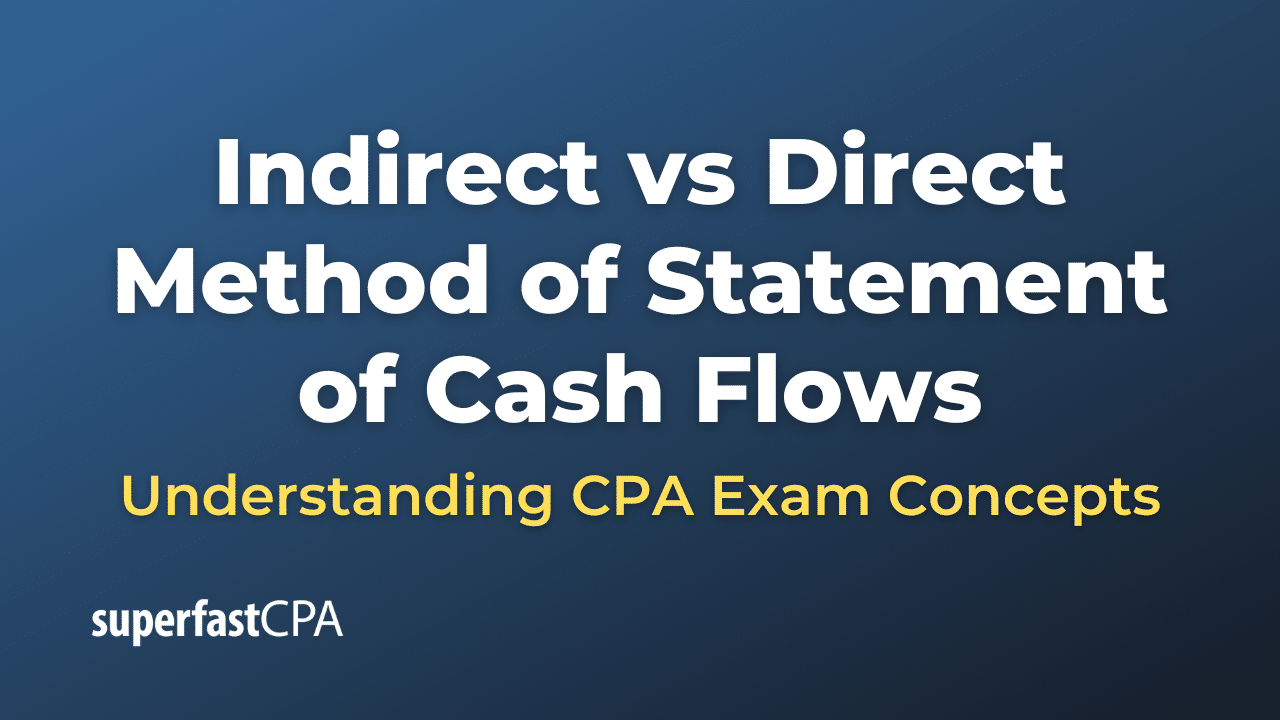
Indirect vs Direct Method of Statement of Cash Flows
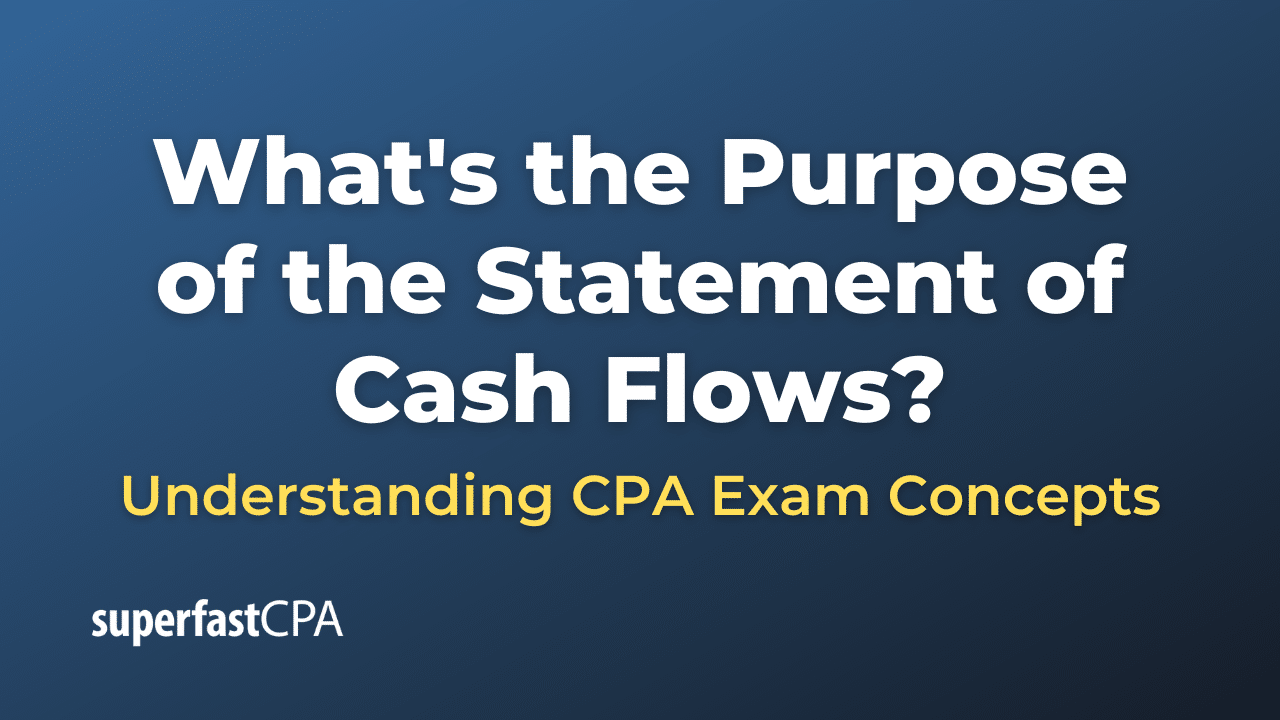
What’s the Purpose of the Statement of Cash Flows?
Helpful links.
- Learn to Study "Strategically"
- How to Pass a Failed CPA Exam
- Samples of SFCPA Study Tools
- SuperfastCPA Podcast

Helicopter Pilot to CPA: How Chase Passed His CPA Exams

How Josh Passed His CPA Exams Using Shorter Study Sessions

The Changes That Helped Marc Pass His CPA Exams After Failing 6 Times

The CPA Study Tweaks Gabi Used to Pass Her CPA Exams

How Skylar Went From a Psychology Major to Becoming a CPA

How Dalton Is Passing Exams by Making His CPA Study a Lifestyle
Want to pass as fast as possible, ( and avoid failing sections ), watch one of our free "study hacks" trainings for a free walkthrough of the superfastcpa study methods that have helped so many candidates pass their sections faster and avoid failing scores....

Make Your Study Process Easier and more effective with SuperfastCPA
Take Your CPA Exams with Confidence
- Free "Study Hacks" Training
- SuperfastCPA PRO Course
- SuperfastCPA Review Notes
- SuperfastCPA Audio Notes
- SuperfastCPA Quizzes
Get Started
- Free "Study Hacks Training"
- Read Reviews of SuperfastCPA
- Busy Candidate's Guide to Passing
- Subscribe to the Podcast
- Purchase Now
- Nate's Story
- Interviews with SFCPA Customers
- Our Study Methods
- SuperfastCPA Reviews
- CPA Score Release Dates
- The "Best" CPA Review Course
- Do You Really Need the CPA License?
- 7 Habits of Successful Candidates
- "Deep Work" & CPA Study
- Cost Classifications
- Relevant Cost of Material
- Manufacturing Overhead Costs
- Conversion Costs
- Quality Costs
- Revenue Expenditure
- Product Cost vs Period Cost
- Direct Costs and Indirect Costs
- Prime Costs and Conversion Costs
- Relevant vs Irrelevant Costs
- Avoidable and Unavoidable Costs
- Cost Allocation
- Joint Products
- Accounting for Joint Costs
- Service Department Cost Allocation
- Repeated Distribution Method
- Simultaneous Equation Method
- Specific Order of Closing Method
- Direct Allocation Method
Cost allocation is the process by which the indirect costs are distributed among different cost objects such as a project, a department, a branch, a customer, etc. It involves identifying the cost object, identifying and accumulating the costs that are incurred and assigning them to the cost object on some reasonable basis.
Cost allocation is important for both pricing and planning and control decisions. If costs are not accurately calculated, a business might never know which products are making money and which ones are losing money. If cost are mis-allocated, a business may be charging wrong price to its customers and/or it might be wasting resources on products that are wrongly categorized as profitable.
Cost allocation is a sub-process of cost assignment , which is the overall process of finding total cost of a cost object. Cost assignment involves both cost tracing and cost allocation. Cost tracing encompasses finding direct costs of a cost object while the cost allocation is concerned with indirect cost charge.
Steps in cost allocation process
Typical cost allocation mechanism involves:
- Identifying the object to which the costs have to be assigned,
- Accumulating the costs in different pools,
- Identifying the most appropriate basis/method for allocating the cost.
Cost object
A cost object is an item for which a business need to separately estimate cost.
Examples of cost object include a branch, a product line, a service line, a customer, a department, a brand, a project, etc.
A cost pool is the account head in which costs are accumulated for further assignment to cost objects.
Examples of cost pools include factory rent, insurance, machine maintenance cost, factory fuel, etc. Selection of cost pool depends on the cost allocation base used. For example if a company uses just one allocation base say direct labor hours, it might use a broad cost pool such as fixed manufacturing overheads. However, if it uses more specific cost allocation bases, for example labor hours, machine hours, etc. it might define narrower cost pools.
Cost driver
A cost driver is any variable that ‘drives’ some cost. If increase or decrease in a variable causes an increase or decrease is a cost that variable is a cost driver for that cost.
Examples of cost driver include:
- Number of payments processed can be a good cost driver for salaries of Accounts Payable section of accounting department,
- Number of purchase orders can be a good cost driver for cost of purchasing department,
- Number of invoices sent can be a good cost driver for cost of billing department,
- Number of units shipped can be a good cost driver for cost of distribution department, etc.
While direct costs are easily traced to cost objects, indirect costs are allocated using some systematic approach.
Cost allocation base
Cost allocation base is the variable that is used for allocating/assigning costs in different cost pools to different cost objects. A good cost allocation base is something which is an appropriate cost driver for a particular cost pool.
T2F is a university café owned an operated by a student. While it has plans for expansion it currently offers two products: (a) tea & coffee and (b) shakes. It employs 2 people: Mr. A, who looks after tea & coffee and Mr. B who prepares and serves shakes & desserts.
Its costs for the first quarter are as follows:
Total tea and coffee sales and shakes sales were $50,000 & $60,000 respectively. Number of customers who ordered tea or coffee were 10,000 while those ordering shakes were 8,000.
The owner is interested in finding out which product performed better.
Salaries of Mr. A & B and direct materials consumed are direct costs which do not need any allocation. They are traced directly to the products. The rest of the costs are indirect costs and need some basis for allocation.
Cost objects in this situation are the products: hot beverages (i.e. tea & coffee) & shakes. Cost pools include rent, electricity, music, internet and wi-fi subscription and magazines.
Appropriate cost drivers for the indirect costs are as follows:
Since number of customers is a good cost driver for almost all the costs, the costs can be accumulated together to form one cost pool called manufacturing overheads. This would simply the cost allocation.
Total manufacturing overheads for the first quarter are $19,700. Total number of customers who ordered either product are 18,000. This gives us a cost allocation base of $1.1 per customer ($19,700/18,000).
A detailed cost assignment is as follows:
Manufacturing overheads allocated to Tea & Cofee = $1.1×10,000
Manufacturing overheads allocated to Shakes = $1.1×8,000
by Irfanullah Jan, ACCA and last modified on Jul 22, 2020
Related Topics
- Cost Behavior
All Chapters in Accounting
- Intl. Financial Reporting Standards
- Introduction
- Accounting Principles
- Business Combinations
- Accounting Cycle
- Financial Statements
- Non-Current Assets
- Fixed Assets
- Investments
- Revenue Recognition
- Current Assets
- Receivables
- Inventories
- Shareholders' Equity
- Liability Accounts
- Accounting for Taxes
- Employee Benefits
- Accounting for Partnerships
- Financial Ratios
- Cost Accounting Systems
- CVP Analysis
- Relevant Costing
- Capital Budgeting
- Master Budget
- Inventory Management
- Cash Management
- Standard Costing
Current Chapter
XPLAIND.com is a free educational website; of students, by students, and for students. You are welcome to learn a range of topics from accounting, economics, finance and more. We hope you like the work that has been done, and if you have any suggestions, your feedback is highly valuable. Let's connect!
Copyright © 2010-2024 XPLAIND.com
Our Recommendations
- Best Small Business Loans for 2024
- Businessloans.com Review
- Biz2Credit Review
- SBG Funding Review
- Rapid Finance Review
- 26 Great Business Ideas for Entrepreneurs
- Startup Costs: How Much Cash Will You Need?
- How to Get a Bank Loan for Your Small Business
- Articles of Incorporation: What New Business Owners Should Know
- How to Choose the Best Legal Structure for Your Business
Small Business Resources
- Business Ideas
- Business Plans
- Startup Basics
- Startup Funding
- Franchising
- Success Stories
- Entrepreneurs
- The Best Credit Card Processors of 2024
- Clover Credit Card Processing Review
- Merchant One Review
- Stax Review
- How to Conduct a Market Analysis for Your Business
- Local Marketing Strategies for Success
- Tips for Hiring a Marketing Company
- Benefits of CRM Systems
- 10 Employee Recruitment Strategies for Success
- Sales & Marketing
- Social Media
- Best Business Phone Systems of 2024
- The Best PEOs of 2024
- RingCentral Review
- Nextiva Review
- Ooma Review
- Guide to Developing a Training Program for New Employees
- How Does 401(k) Matching Work for Employers?
- Why You Need to Create a Fantastic Workplace Culture
- 16 Cool Job Perks That Keep Employees Happy
- 7 Project Management Styles
- Women in Business
- Personal Growth
- Best Accounting Software and Invoice Generators of 2024
- Best Payroll Services for 2024
- Best POS Systems for 2024
- Best CRM Software of 2024
- Best Call Centers and Answering Services for Busineses for 2024
- Salesforce vs. HubSpot: Which CRM Is Right for Your Business?
- Rippling vs Gusto: An In-Depth Comparison
- RingCentral vs. Ooma Comparison
- Choosing a Business Phone System: A Buyer’s Guide
- Equipment Leasing: A Guide for Business Owners
- HR Solutions
- Financial Solutions
- Marketing Solutions
- Security Solutions
- Retail Solutions
- SMB Solutions

Online only.

What Is Cost Allocation?

Table of Contents
For your business to make money, you must charge prices that not only cover your expenses, but also provide a profit. Cost allocation is the process of identifying and assigning costs to the cost objects in your business, such as products, a project, or even an entire department or individual company branch.
While a detailed cost allocation report may not be vital for extremely small businesses, such as a teen’s lawn service, more complex businesses require the process of cost allocation to ensure profitability and productivity.
In short, if you can assign a cost to any part of your business, it’s considered a cost object.
What is cost allocation?
Cost allocation is the method business owners use to calculate profitability for the purpose of financial reporting . To ensure the business’s finances are on track, costs are separated, or allocated, into different categories based on the area of the business they impact.
For instance, cost allocation for a small clothing boutique would include the costs of materials, shipping and marketing. Calculating these costs consistently would help the store owner ensure that profits from sales are higher than the costs of owning and running the store. If not, the owner could easily pinpoint where to raise prices or cut expenses .
For a larger company, this process would be applied to each department or individual location. Many companies use cost allocation to determine which areas receive bonuses annually.
Regardless of your business size, you’ll want to review and choose the best accounting software to help this process run as smoothly as possible.
Types of costs
In the boutique example above, the process of cost allocation is pretty simple. For larger businesses, however, many more costs are involved. These costs break down into seven categories.
- Direct costs: These expenses are directly related to a product or service. In your business’s financial statements, these costs can be linked to items sold. For a small clothing store, this might include the cost of inventory.
- Direct labor: This cost category includes expenses directly related to the employee production of items or services your business sells. Direct labor costs include payroll for employees involved in making the items your business sells.
- Direct materials: As the name suggests, this category includes costs related to the resources used to manufacture a finished product. Direct materials include fabric to make clothing, or the glass used in building tables.
- Indirect costs: These expenses are not directly related to a product or service, but necessary to create the product or service. Indirect costs include payroll for those who work in operations. It also lists costs for materials you use in such small quantities that their costs are easy to overlook.
- Manufacturing overhead: This category includes warehouse costs, and any other expenses directly related to manufacturing the products sold. Manufacturing overhead costs include payroll for warehouse managers, as well as warehouse expenses such as rent and utilities.
- Overhead costs: These include expenses that support the company as a whole but are not directly related to production. Some examples of overhead costs are marketing, operations and utilities for a storefront.
- Product costs: Also called “manufacturing costs” or “total costs,” this category includes expenses for making or acquiring the product you sell. All manufacturing overhead costs are also listed in this category.
Example of cost allocation
To better explain the process of cost allocation and why it’s necessary for businesses, let’s look at an example.
Dave owns a business that manufactures eyeglasses. In January, Dave’s overhead costs totaled $5,000. In the same month, he produced 3,000 eyeglasses with $2 in direct labor per product. Direct materials for each pair of eyeglasses totaled $5.
Here’s what cost allocation would look like for Dave:
Overhead: $5,000 ÷ $3,000 = $1.66 per pair
Direct costs:
- Direct materials: $5 per pair
- Direct labor: $2 per pair
- Overhead: $1.66 per pair
- Total cost: $8.66 per pair
As you can see, without cost allocation, Dave would not have made a profit from his sales. Larger companies would apply this same process to each department and product to ensure sufficient sales goals. [Read related article: How to Set Achievable Business Goals ]
How to allocate costs
Cost objects vary by business type. The cost allocation process, however, consists of the same steps regardless of what your company produces.
1. Identify cost objects.
To begin allocating costs, you’ll need to list the cost objects of your business. Remember that anything within your business that generates an expense is a cost object. Review each product line, project and department to ensure you’ve gathered all cost objects.
2. Create a cost pool.
Next, gather a detailed list of all business costs. It’s a good idea to categorize the costs based on the reason for each amount. Categories should cover utilities, insurance , square footage and any other expenses your business incurs.
3. Allocate costs.
Now that you’ve listed cost objects and created a cost pool, you’re ready to allocate costs. As demonstrated in the example above, add up the costs of each cost object. At a glance, your report should justify all expenses related to your business. If costs don’t add up correctly, use the list to determine where you can make adjustments to get back on track.
What is cost allocation used for?
Cost allocation is used for many reasons, both externally and internally. Reports created by this process are great resources for making business decisions , monitoring productivity and justifying expenses.
External reports are usually calculated based on generally accepted accounting principles (GAAP) . Under GAAP, expenses can only be reported in financial statements during the time period the associated revenue is earned. For this reason, overhead costs are divided and allocated to individual inventory items. When the inventory is sold, the overhead is expensed as a portion of the cost of goods sold (COGS) .
Internal financial data, on the other hand, is usually reported using activity-based costing (ABC). This method assigns all products to the overhead expenses they caused. This process may not include all overhead costs related to operations and manufacturing.
Cost allocation reports show which cost objects incur the most expenses for your business and which products or departments are most profitable. These findings can be a great resource to pair with employee monitoring software when evaluating productivity. If you determine that a cost object is not as profitable as it should be, you should do further evaluations on productivity. If another cost object is found to exceed expectations, you can use the report to find staff members who deserve recognition for their contributions to the company.
Recognition is one of the best ways to keep employees motivated .
What is a cost driver?
A cost driver is a variable that can change the costs related to a business activity. The number of invoices issued, the number of employee hours worked, and the total of purchase orders are all examples of cost drivers in cost accounting .
While cost objects are related to the specific process or product incurring the costs, a cost driver sheds light on the reason for the incurred cost amounts. These items can take different forms – including fixed costs, such as the initial fees during the startup phase . Cost drivers give a bird’s-eye view of the entire company and how each department operates.
It’s common for only one cost driver to be used with very small businesses , since they are focused on using minimal reporting to estimate overhead costs.
Benefits of cost allocation
- It simplifies decision-making. Cost allocation gives you a detailed overview of how your business expenses are used. From this perspective, you can determine which products and services are profitable, and which departments are most productive.
- It assists in staff evaluation. You can also use cost allocation to assess the performance of different departments. If a department is not profitable, the staff productivity may need improvement. Cost allocation can also be an indicator of departments that exceed expectations and deserve recognition. Awards and recognition are a great way to motivate staff and, in turn, increase productivity. [Read related article: Best Business Productivity Apps ]
Even if you operate a very small business, it’s a great idea to learn the process of cost allocation, especially if you anticipate expansion in the future. Since the method can be complex, it’s ideal to use accounting software as an aid. Whether you choose to start allocating costs on your own with software or hire a professional accountant , it’s a process no business owner can afford to overlook.

Building Better Businesses
Insights on business strategy and culture, right to your inbox. Part of the business.com network.
Workflow Solutions
FloQast Close
FloQast Reconciliation Management
FloQast Variance Analysis
FloQast Analyze
FloQast Compliance Management
FloQast Ops
FloQast ReMind
Finance and Accounting Operations Platform
Platform Overview
AI and Machine Learning
Scalability
Trust & Security
Integrations
FloVerse Community
FloQast Studios
FloQast Blog
Controller Manifesto
FloQademy - Join / Sign In

Charting the Future of Accounting eBook
Your next step: navigating the future amidst changes and challenges
Chief Accounting Officer
Accounting Manager
Compliance Manager
Internal Audit Manager
By Workflow
Financial Close
Account Reconciliations
Audit Findings
Controls and Risk Management
SOX Compliance
Audit Readiness
Oracle NetSuite
Sage Intacct
FloQast Connect API
By Platform

The IPO Playbook for Finance & Accounting Teams
An at-a-glance guide to going public
Success Stories
Video Testimonials
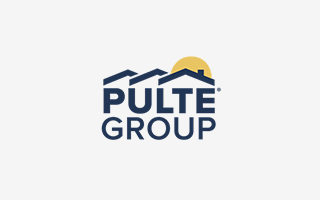
PulteGroup Constructs Faster Close and Team Productivity with FloQast
Learn how FloQast helped PulteGroup reduce paper consumption, speed up its monthly Close, and streamline compliance reporting.
Closing Collaboration in a Multinational Accounting Team: How Emma Improved Team Collaboration and Internal Controls Together with FloQast
Emma's 70-person geographically distributed accounting team improved internal controls and streamlined the audit thanks to FloQast.
Qualys Modernizes SOX Compliance and Improves the Annual Audit with FloQast
Read how in just a matter of weeks, Qualys leveraged FloQast to standardize the close process and organize controls and documentation for a more simplified SOX compliance.
Partner Program
Become a Partner
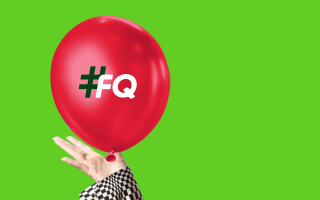
Take Your Business to the Next Level
FloQast’s suite of easy-to-use and quick-to-deploy solutions enhance the way accounting teams already work. Learn how a FloQast partnership will further enhance the value you provide to your clients.
All Resources
Checklists & Templates
Customer Video Testimonials
Whitepapers
Customer Success Stories

Month-End Close Checklist
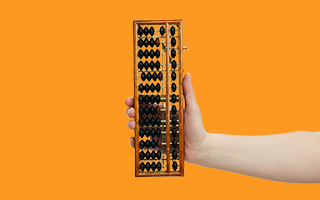
SOX RCM Template
Leverage best practices to build a SOX RCM that focuses on what’s most important for SOX compliance.
Customer Success Management
Customer Success
Global Community
Request Support

Earn Free CPE with FloQademy
FloQademy, FloQast’s learning portal, provides over 100+ hours of free CPE, on-demand, 24/7, and is open to everyone.
The FloQast Advantage
Initiatives
Diversity, Inclusion, & Community
Contact FloQast
Get In Touch
FloQast raises $100M at a $1.6B valuation
The Series E round was led by ICONIQ Growth to supercharge FloQast's global expansion and Innovation with Artificial Intelligence.

What is Cost Allocation? Definition & Process
Jul 16, 2020 Michael Whitmire
Working with the former accountants now working at FloQast, we decided to take a look at some of the pillars of the accounting professions.
The key to running a profitable enterprise of any kind is making sure that your prices are high enough to cover all your costs — and leave at least a bit for profit. For a really simple business — like the proverbial lemonade stand that almost every kid ran — that’s pretty simple. Your costs are what you (or your parents) paid for lemons and sugar. But what if it’s a more complex business? Then you might need to brush up on cost accounting, and learn about allocation accounting . Let’s walk through this using the hypothetical company, Lisa’s Luscious Lemonade.
What is cost allocation ?
The cost allocation definition is best described as the process of assigning costs to the things that benefit from those costs or to cost centers . For Lisa’s Luscious Lemonade, a cost center can be as granular as each jug of lemonade that’s produced, or as broad as the manufacturing plant in Houston.
Let’s assume that the owner, Lisa, needs to know the cost of a jug of lemonade. The total cost to create that jug of lemonade isn’t just the costs of the water, lemons, sugar and the jug itself, but also includes all the allocated costs to make it.
Let’s start by defining some terms…
Direct costs are costs that can be traced directly to the product or service itself. For manufacturers, these consist of direct materials and direct labor. They appear in the financial statements as part of the cost of goods sold .
Direct materials are those that become an integral part of the finished product. This will be the costs of the water, sugar, lemons, the plastic jug, and the label.
Direct labor includes the labor costs that can be easily traced to the production of those finished products. Direct labor for that jug will be the payroll for the workers on the production line.
Indirect costs are the costs that can’t be easily traced to a product or service but are clearly required for making whatever an enterprise sells. This includes materials that are used in such insignificant quantities that it’s not worth tracing them to finished products, and labor for employees who work in the factory, but not on the production line.
Overhead costs encompass all the costs that support the enterprise that can’t be directly linked to making the items that are sold. This includes indirect costs , as well as selling, marketing, administration, and facility costs.
Manufacturing overhead includes the overhead costs that are directly related to making the products for sale. This includes the electricity, rent, and utilities for the factory and salaries of supervisors on the factory floor.
Product costs are all the costs in making or acquiring the product for sale. These are also known as manufacturing costs or total costs . This includes direct labor, direct materials, and allocated manufacturing overhead.
What is the process?
The first step in any cost allocation system is to identify the cost objects to which costs need to be allocated. Here, our cost objec t is a jug of lemonade. For a more complex organization, the cost object could be a product line, a department, or a branch.
Direct costs are the simplest to allocate. Last month, Lisa’s Luscious Lemonades produced 50,000 gallons of lemonade and had the following direct costs:
Total costs Cost per gallon Direct materials $142,500 $2.85 Direct labor $37,500 $.75
How are costs allocated?
Allocating overhead costs is a bit more complex. First, the overhead costs are split between manufacturing costs and non-manufacturing costs. Some of this is pretty straightforward: the factory floor supervisor’s salary is clearly a manufacturing cost, and the sales manager’s salary is a non-manufacturing cost. But what about the cost of human resources or other service departments that serve all parts of the organization? Or facilities costs, which might include the rent for the building, insurance, utilities, janitorial services, and general building maintenance?
Human resources and other services costs might be logically split based on the headcount of the manufacturing versus non-manufacturing parts of the business. Facilities costs might be split based on the square footage of the manufacturing space versus the administrative offices. Electricity usage might be allocated on the basis of square footage or machine hours , depending on the situation.
Let’s say that for Lisa’s Luscious Lemonades, after we split the overhead between manufacturing and non-manufacturing costs, we have the following annual manufacturing overhead costs :
Supervisor salary $84,000 Indirect costs $95,000 Facility costs $150,000 Human resources $54,000 Depreciation $65,000 Electricity $74,000 Total manufacturing overhead $522,000
In a perfect world, it would be possible to keep an accurate running total of all overhead costs so that management would have detailed and accurate cost information. However, in practice, a predetermined overhead rate is used to allocate overhead using an allocation base .
This overhead rate is determined by dividing the total estimated manufacturing overhead by the estimated total units in the allocation base . At the end of the year or quarter, the allocated costs are reconciled to actual costs.
Ideally, the allocation base should be a cost driver that causes those overhead costs . For manufacturers, direct labor hours or machine-hours are commonly used. Since Lisa only makes one product — gallon jugs of lemonade — the simplest cost driver is the number of jugs produced in a year.
If we estimate that 600,000 gallons of lemonade are produced in a year, then the overhead rate will be $522,000 / 600,000 = $.87 per gallon.
Our final cost to produce a gallon of Lisa’s Luscious Lemonade is as follows:
Direct materials $2.85 Direct labor $0.75 Manufacturing overhead $0.87 Total cost $4.47
What is cost allocation used for?
Cost allocation is used for both external reporting and internally for decision making. Under generally accepted accounting principles (GAAP), the matching principle requires that expenses be reported in the financial statements in the same period that the related revenue is earned.
This means that manufacturing overhead costs cannot be expensed in the period incurred, but must be allocated to inventory items, where those costs remain until the inventory is sold, when overhead is finally expensed as part of the cost of goods sold. For Lisa’s Luscious Lemonade, that means that every time a jug of lemonade is produced, another $4.47 goes into inventory. When a jug is sold, $4.47 goes to the cost of goods sold.
However, for internal decision-making, the cost allocation systems used for GAAP financials aren’t always helpful. Cost accountants often use activity-based costing , or ABC, in parallel with the cost allocation system used for external financial reporting .
In ABC, products are assigned all of the overhead costs that they can reasonably be assumed to have caused. This may include some — but not all — of the manufacturing overhead costs , as well as operating expenses that aren’t typically assigned to products under the costing systems used for GAAP.
AutoRec to keep you sane
Whatever cost accounting method you use, it’s going to require spreadsheets that you have to reconcile to the GL. Combine that with the other reconciliations you have to do to close out the books, and like Lisa’s controller, you might be ready to jump into a vat of lemonade to drown your sorrows.
Enter FloQast AutoRec. Rather than spend hours every month reconciling accounts, AutoRec leverages AI to match one-to-one, one-to-many, or many-to-many transactions in minutes. Simple set up means you can start using it in minutes because you don’t need to create or maintain rules. Try it out, and see how much time you can save this month.
Ready to find out more about how FloQast can help you tame the beast of the close?

Michael Whitmire
As CEO and Co-Founder, Mike leads FloQast’s corporate vision, strategy and execution. Prior to founding FloQast, he managed the accounting team at Cornerstone OnDemand, a SaaS company in Los Angeles. He began his career at Ernst & Young in Los Angeles where he performed public company audits, opening balance sheet audits, cash to GAAP restatements, compilation reviews, international reporting, merger and acquisition audits and SOX compliance testing. He holds a Bachelor’s degree in Accounting from Syracuse University.
Related Blog Articles
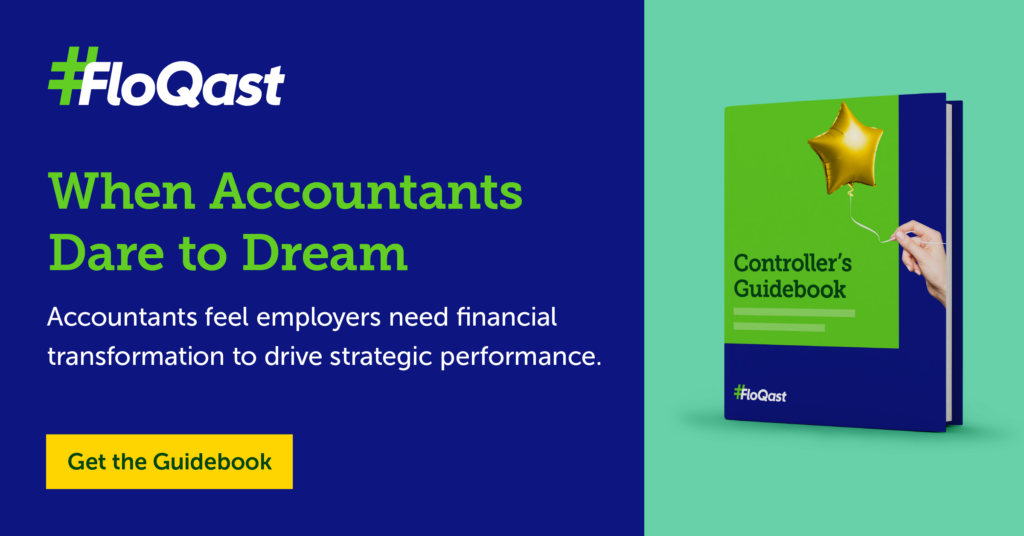
Report: Accountants Want Financial Transformation, but Lack of Fulfillment and Confidence Stand in the Way
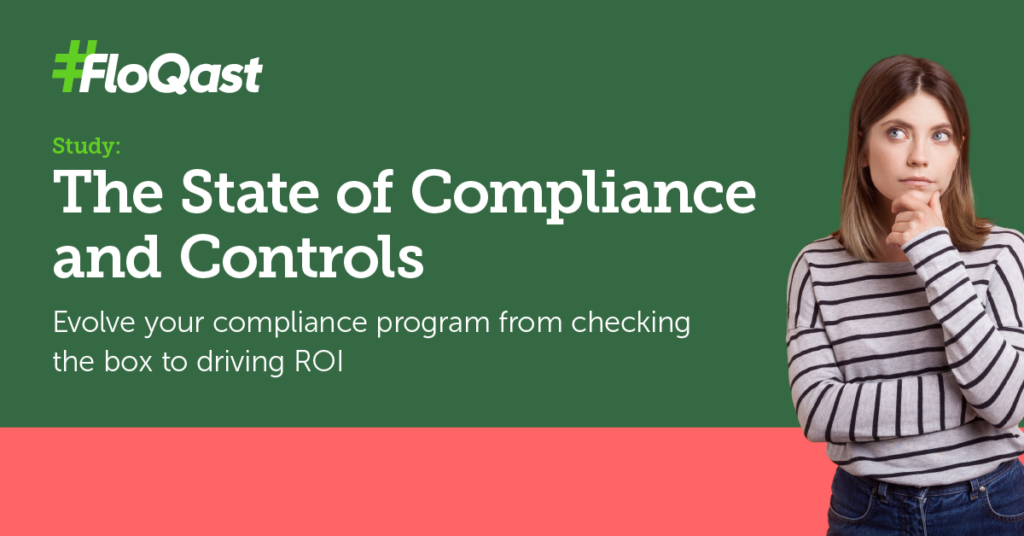
Study: Compliance and Controls Processes Are Struggling

Report: Analyzing Accountants’ Relationship with Technology as Stressor in the Workplace – and at Home
404 Not found

- school Campus Bookshelves
- menu_book Bookshelves
- perm_media Learning Objects
- login Login
- how_to_reg Request Instructor Account
- hub Instructor Commons
- Download Page (PDF)
- Download Full Book (PDF)
- Periodic Table
- Physics Constants
- Scientific Calculator
- Reference & Cite
- Tools expand_more
- Readability
selected template will load here
This action is not available.

2.6: Process Costing (FIFO Method)
- Last updated
- Save as PDF
- Page ID 65679
Another acceptable method for determining unit cost under process costing is the first-in, first-out (FIFO) cost method. Under the FIFO method, we assume any units that were not completed last period (beginning work in process) are finished before anything else is started. The following table shows the differences between the weighted average method and the FIFO cost method:
We will look at each item individually as we discuss the steps of process costing. Under either method, weighted average or FIFO, process costing consists of 5 steps:
Physical Flow of Units
- Equivalent Units
Cost per Equivalent Unit
- Assign Costs to Units Completed and Ending Work in Process Inventory
Reconcile Costs
The physical flow of units is as follows under the weighted average method:
This is altered just slightly under the FIFO method as we must separate the items in units completed into Units Completed from beginning work in process and Units started and completed this period since under FIFO, we must finish anything from beginning work in process before we start something new. Under the FIFO, we the physical flow of units would be documented as:
Just as in the weighted average method, the 2 Total Units figures must agree!
Equivalent Units of Production
Under the FIFO method, we will calculate equivalent units for 3 things: Units completed from beginning work in process, units started and completed this period and units remaining in ending work in process. This video will discuss the differences between the Weighted Average and FIFO methods for equivalent units (if you are comfortable with the weighted average method, skip to minute 4:06 to begin the discussion on the FIFO method).

A YouTube element has been excluded from this version of the text. You can view it online here: http://pb.libretexts.org/ma/?p=78
Equivalent units for the period will be calculated as follows under FIFO ( keep in mind, you may have different percent complete for materials, labor and overhead ):
- Units from beginning work in process: you want to complete this units, so how much MORE effort will be needed to finish these units. You will calculate this as beginning work in process units x (100% – given % complete) to calculate the amount of additional work necessary to make the unit 100% complete.
- Units started and completed this period: take the units x 100% complete since they were started and completed they have received all of their materials, labor and overhead and will not receive any more since they are finished.
- Units in Ending work in process: just like with the weighted average method, we will take the ending work in process units x a given % complete.
To illustrate the computation of equivalent units under the FIFO method, assume the following facts (for simplicity we are using just one percent complete for materials, labor and overhead):
The physical flow of units would be (calculate units started and completed as units started 10,000 – units in ending work in process 5,000):
The equivalent production for the period would be:
Under the weighted average method, we use beginning work in process costs AND costs added this period. Under the FIFO method, we will only use the costs added this period. This video will explain the differences between the two approaches.
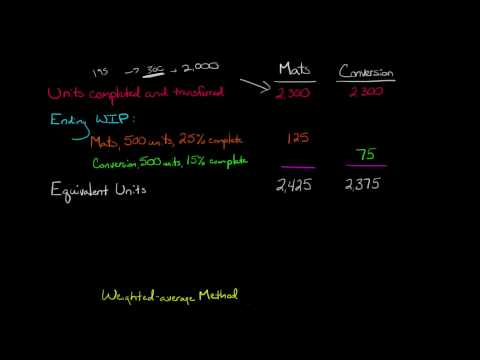
The formula we will use for calculating cost per equivalent unit under the FIFO Method is:
Assign Costs
When we assign costs to units completed and transferred and units remaining in ending work in process under the FIFO method, we need the following items:
- Costs from beginning work in process: these were the costs we started the period with or the unfinished items from the previous period ( no calculation required — just bring over the costs from beginning work in process ). Remember, under FIFO, these are finished first so their costs must be passed along to completed units.
- Costs to complete beginning work in process: you will take the Equivalent units calculated for completing beginning work in process x the cost per equivalent unit. You will do this for materials, labor and overhead (or for conversion costs which is the both direct labor and overhead).
- Costs of units started and completed: you will take the equivalent units calculated for units started and completed x the cost per equivalent unit for materials, labor and overhead (or conversion).
- The sum of these 3 will be the cost of units completed and transferred which is also known as cost of goods manufactured. This amount is transferred to the next department or to finished goods and out of work in process for the units completed this period.
- Cost of units remaining in ending work in process: you will take the ending work in process equivalent units x the cost per equivalent unit for materials, labor and overhead (or conversion) just as we did under the weighed average method. This amount rolls over to be the next period’s beginning work in process inventory.
This video will provide a demonstration of cost assignment under the FIFO method.

Finally, something is the same under FIFO and Weighted Average.
We want to make sure that we have assigned all the costs from beginning work in process and costs incurred or added this period to units completed and transferred and ending work in process inventory.
First, we need to know our total costs for the period (or total costs to account for) by adding beginning work in process costs to the costs incurred or added this period. Then, we compare the total to the cost assignment in step 4 for units completed and transferred and ending work in process to get total units accounted for. Both totals should agree.
The cost reconciliation would be:
In the next page, we will do a demonstration problem of the FIFO method for process costing.
Contributors and Attributions
- Equivalent Units. Authored by : Linda Williams. License : All Rights Reserved . License Terms : Standard YouTube License
- Cost Per Equivalent Unit-- FIFO Method vs. Weighted-average Method . Authored by : Education Unlocked. Located at : https://youtu.be/P_Nwchc_pcs . License : All Rights Reserved . License Terms : Standard YouTube License
- Cost Per Equivalent Unit, FIFO Method, Part 2 (Applying Costs) . Authored by : Education Unlocked. Located at : https://youtu.be/y1TLRSL9Yjo . License : All Rights Reserved . License Terms : Standard YouTube License
principlesofaccounting.com

Cost Allocation To Completed Units And Units In Process
- Goals Achievement
- Fill in the Blanks
- Multiple Choice
The cost per equivalent unit calculations are used to allocate cost incurred between a department’s completed production and the units in ending work in process. Carefully examine the following schedule to see that the cost assigned to completed units totals $8,027,500. The ending work in process is $1,460,000, determined as 125,000 equivalent units at $9.00 each, plus 100,000 equivalent units of conversion at $3.35 each.
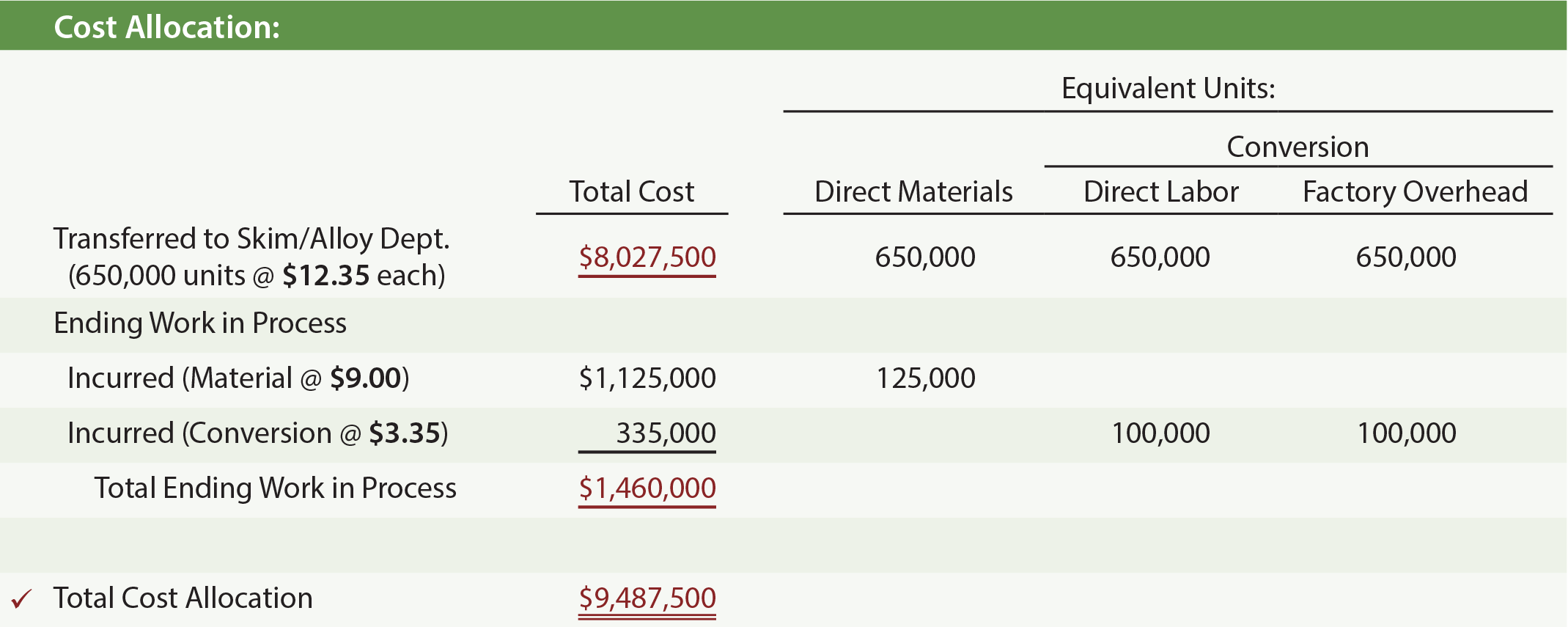
Note that a check mark is placed beside the total cost allocation ($9,487,500 = $8,027,500 + $1,460,000) as a reminder that this schedule must allocate the entire cost incurred within the Melting Department.
Cost Of Production Report
The preceding schedules are combined into a single cost of production report as shown below. A similar report would be prepared for each department.
These reports are used for many management purposes, such as inventory control, efficiency studies, incentive pay plans, and the like. They also provide the basis for the following entries that are needed to update the ledger accounts for the inventory cost allocations.
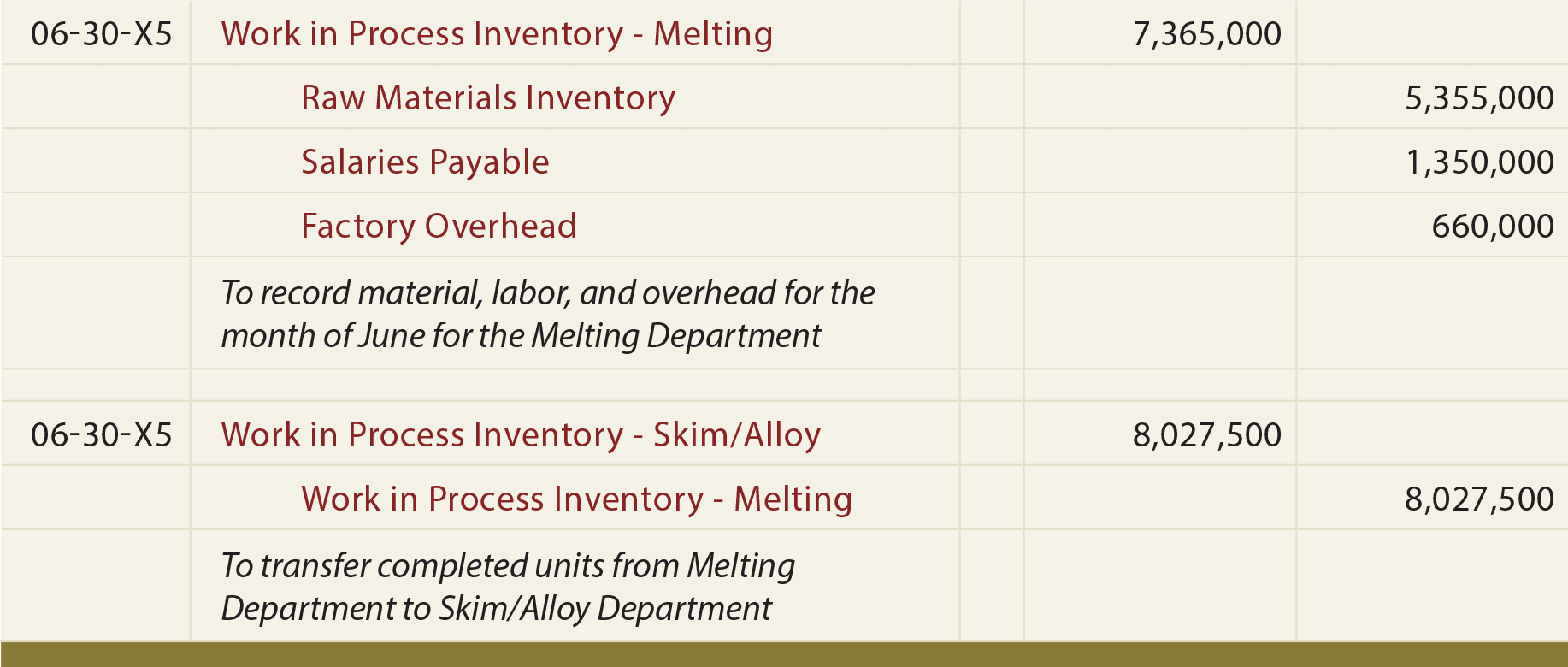
Analysis of Cost Flow
The journal entries, along with the beginning work in process of $2,122,500, result in an ending work in process of $1,460,000.
The following T-account portrays the cost flow through the Work in Process account of the Melting Department:

Added Processes
It is important to notice that the journal entry to transfer $8,027,500 out of the Melting Department (credit) is offset with an increase in the Work in Process of the Skim/Alloy Department (debit).
The Skim/Alloy Department’s T-account for June might look something like this (amounts are assumed):

The corresponding journal entries for the Skim/Alloy Department for June are as follows:
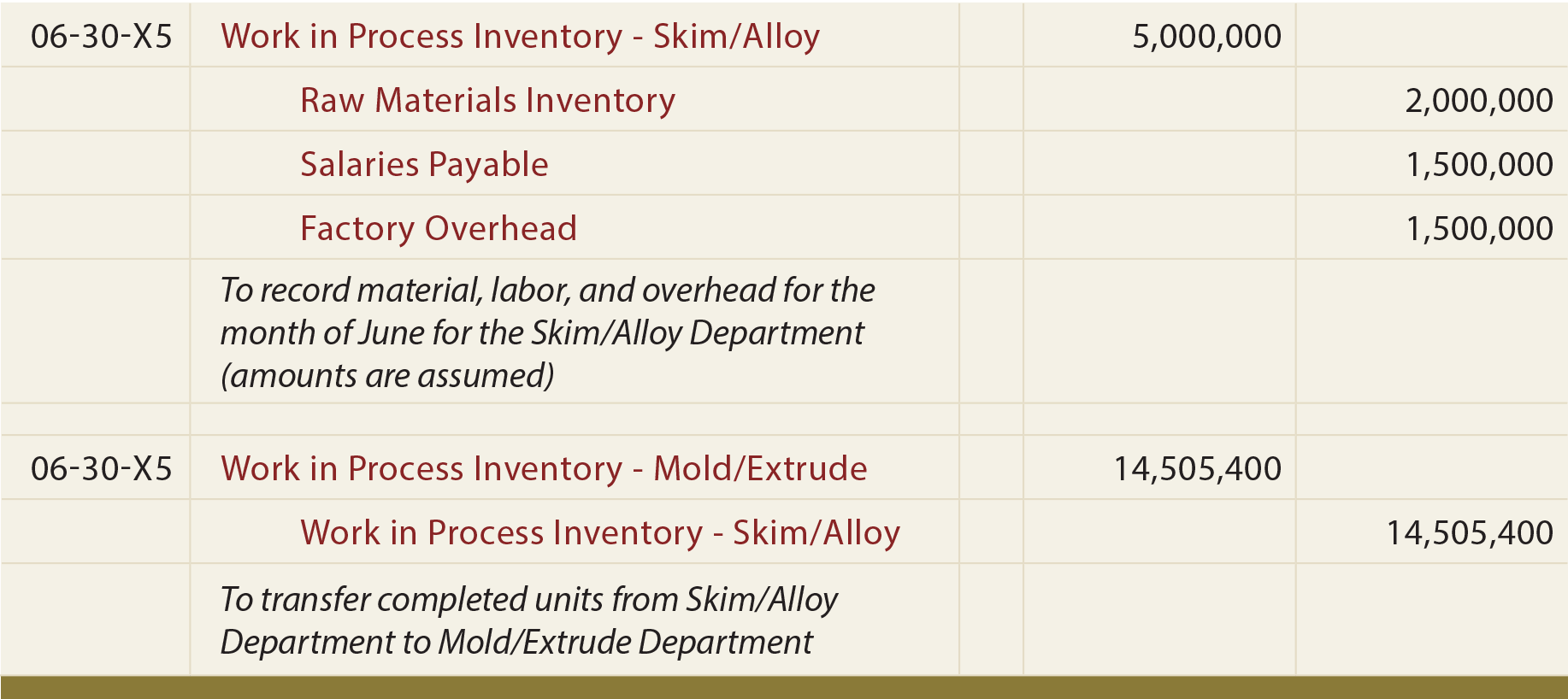
Assume the Mold/Extrude Department has the following T-account and related entries.

The costs transferred from the Mold/Extrude unit go to the finished goods inventory since this is the final process.
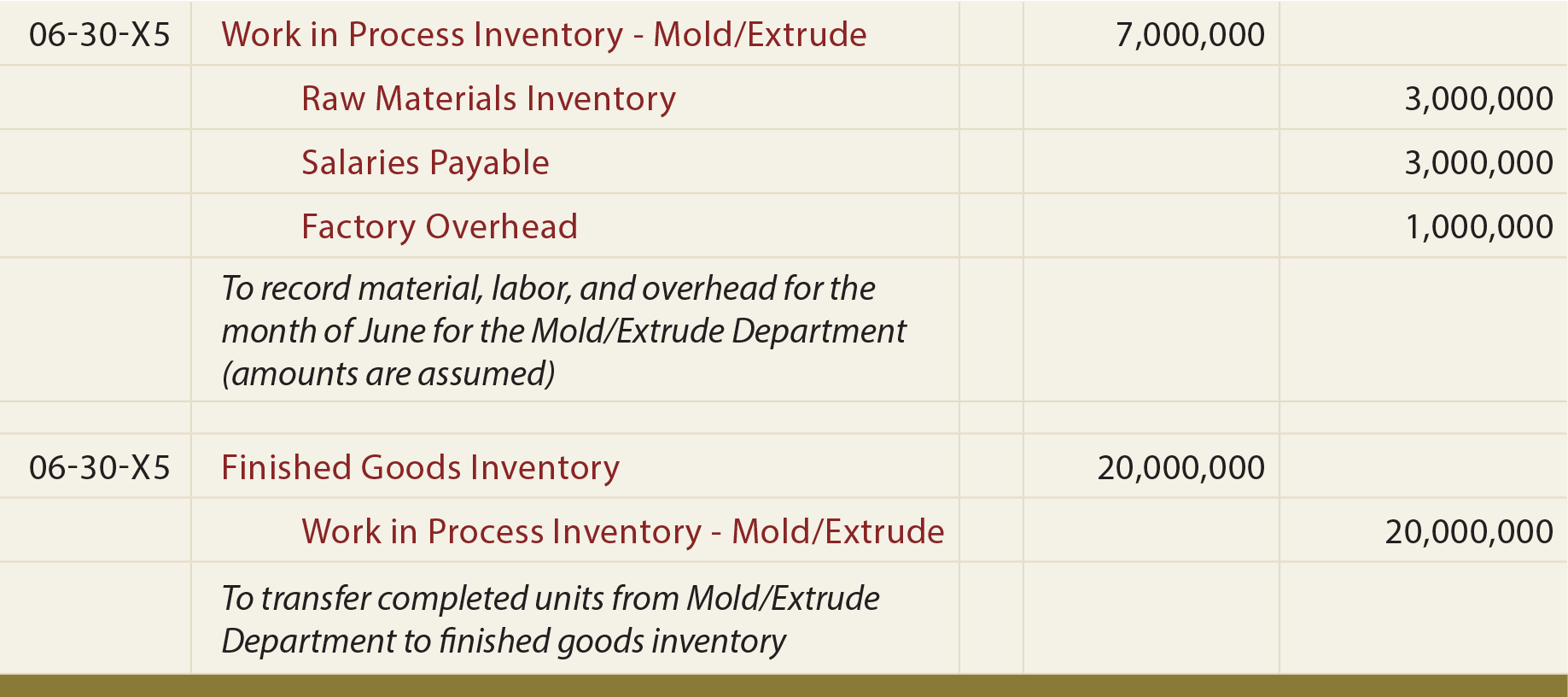
As noted within the journal entry descriptions, all costs for each department were assumed. But, overhead is not in direct proportion to salaries payable for each department. This is not unexpected as there is no requirement that overhead be applied at the same rate, or on the same basis, in different departments.
Overall Review
The schedule below shows that Navarro incurred $19,365,000 in costs and transferred $20,000,000 to finished goods. Total work in process inventory declined by $635,000. This is verified by comparing the beginning and ending work in process balances ($7,622,500 – $6,987,500 = $635,000). Navarro’s balance sheet at June 30 would include $6,987,500 as work in process inventory.

Chapter 3: Process Cost System
3.5 process costing (fifo method).
Another acceptable method for determining unit cost under process costing is the first-in, first-out (FIFO) cost method. Under the FIFO method, we assume any units that were not completed last period (beginning work in process) are finished before anything else is started. The following table shows the differences between the weighted average method and the FIFO cost method:
We will look at each item individually as we discuss the steps of process costing. Under either method, weighted average or FIFO, process costing consists of 5 steps:
- Physical Flow of Units
- Equivalent Units
- Cost per Equivalent Unit
- Assign Costs to Units Completed and Ending Work in Process Inventory
- Reconcile Costs
Physical Flow of Units
The physical flow of units is as follows under the weighted average method:
This is altered just slightly under the FIFO method as we must separate the items in units completed into Units Completed from beginning work in process and Units started and completed this period since under FIFO, we must finish anything from beginning work in process before we start something new. Under the FIFO, we the physical flow of units would be documented as:
Just as in the weighted average method, the 2 Total Units figures must agree!
Equivalent Units of Production
Under the FIFO method, we will calculate equivalent units for 3 things: Units completed from beginning work in process, units started and completed this period and units remaining in ending work in process. This video will discuss the differences between the Weighted Average and FIFO methods for equivalent units (if you are comfortable with the weighted average method, skip to minute 4:06 to begin the discussion on the FIFO method).
Equivalent units for the period will be calculated as follows under FIFO ( keep in mind, you may have different percent complete for materials, labor and overhead ):
- Units from beginning work in process: you want to complete this units, so how much MORE effort will be needed to finish these units. You will calculate this as beginning work in process units x (100% – given % complete) to calculate the amount of additional work necessary to make the unit 100% complete.
- Units started and completed this period: take the units x 100% complete since they were started and completed they have received all of their materials, labor and overhead and will not receive any more since they are finished.
- Units in Ending work in process: just like with the weighted average method, we will take the ending work in process units x a given % complete.
To illustrate the computation of equivalent units under the FIFO method, assume the following facts (for simplicity we are using just one percent complete for materials, labor and overhead):
The physical flow of units would be (calculate units started and completed as units started 10,000 – units in ending work in process 5,000):
The equivalent production for the period would be:
Cost per Equivalent Unit
Under the weighted average method, we use beginning work in process costs AND costs added this period. Under the FIFO method, we will only use the costs added this period. This video will explain the differences between the two approaches.
The formula we will use for calculating cost per equivalent unit under the FIFO Method is:
Assign Costs
When we assign costs to units completed and transferred and units remaining in ending work in process under the FIFO method, we need the following items:
- Costs from beginning work in process: these were the costs we started the period with or the unfinished items from the previous period ( no calculation required — just bring over the costs from beginning work in process ). Remember, under FIFO, these are finished first so their costs must be passed along to completed units.
- Costs to complete beginning work in process: you will take the Equivalent units calculated for completing beginning work in process x the cost per equivalent unit. You will do this for materials, labor and overhead (or for conversion costs which is the both direct labor and overhead).
- Costs of units started and completed: you will take the equivalent units calculated for units started and completed x the cost per equivalent unit for materials, labor and overhead (or conversion).
- The sum of these 3 will be the cost of units completed and transferred which is also known as cost of goods manufactured. This amount is transferred to the next department or to finished goods and out of work in process for the units completed this period.
- Cost of units remaining in ending work in process: you will take the ending work in process equivalent units x the cost per equivalent unit for materials, labor and overhead (or conversion) just as we did under the weighed average method. This amount rolls over to be the next period’s beginning work in process inventory.
This video will provide a demonstration of cost assignment under the FIFO method.
Reconcile Costs
Finally, something is the same under FIFO and Weighted Average.
We want to make sure that we have assigned all the costs from beginning work in process and costs incurred or added this period to units completed and transferred and ending work in process inventory.
First, we need to know our total costs for the period (or total costs to account for) by adding beginning work in process costs to the costs incurred or added this period. Then, we compare the total to the cost assignment in step 4 for units completed and transferred and ending work in process to get total units accounted for. Both totals should agree.
The cost reconciliation would be:
In the next page, we will do a demonstration problem of the FIFO method for process costing.
- Equivalent Units. Authored by : Linda Williams. License : All Rights Reserved . License Terms : Standard YouTube License
- Cost Per Equivalent Unit-- FIFO Method vs. Weighted-average Method . Authored by : Education Unlocked. Located at : https://youtu.be/P_Nwchc_pcs . License : All Rights Reserved . License Terms : Standard YouTube License
- Cost Per Equivalent Unit, FIFO Method, Part 2 (Applying Costs) . Authored by : Education Unlocked. Located at : https://youtu.be/y1TLRSL9Yjo . License : All Rights Reserved . License Terms : Standard YouTube License

Understanding Cost Objects – What They Are and Why They Matter
Businesses must clearly understand their costs as they strive to make informed financial decisions. One tool that companies use to track and manage their costs is cost objects.
But what exactly is a cost object, and how is it used in accounting and finance? In this blog post, we will explore the definition of cost objects, common types used in business and finance, and their role in cost accounting.
We will also answer frequently asked questions, including who assigns costs to cost objects and why we assign them. We will also discuss the challenges businesses may face when assigning costs and provide examples of cost objects used in the manufacturing industry.
Finally, we will explore techniques for allocating costs to cost objects and discuss how the size of a business can impact its use. By the end of this post, you will have a comprehensive understanding of cost objects and their importance in managing business finances.
What Is a Cost Object and How Is It Defined in Accounting and Finance? – Understanding Cost Objects
In accounting and finance, a cost object consumes resources or generates costs within a business or organization. It can be a product, service, project, department, customer, or any other entity that requires resources and generates costs.
A cost object can help identify the costs associated with producing a particular product or service, performing a specific activity, or serving a typical customer. This information can then be used to make more informed decisions about pricing, resource allocation, and process improvements .
For example, each bike would be a cost object in a manufacturing company that produces bicycles. The costs associated with producing each bicycle, such as materials, labor, and overhead expenses, would be tracked and assigned to that cost object.
This information can then be used to determine the true cost of each bicycle and make more informed decisions about pricing, production processes, and resource allocation.
In service-based businesses, cost objects can be more challenging to identify. For example, each project or client could be a cost object in a consulting firm. The costs associated with each project or client, such as labor and travel expenses, would be tracked and assigned to that cost object.
There are two types of cost objects: direct and indirect. Direct cost objects can be traced to a particular product, service, or activity. Indirect cost objects are not easily traced back to a particular product, service, or activity but consume resources and generate costs.
It is essential to accurately assign costs to cost objects to make more informed decisions about pricing, resource allocation, and process improvements. Failure to accurately assign costs to cost objects can lead to inaccurate pricing decisions, inefficient use of resources, and ultimately lower profits.
What Are Some Common Types of Cost Objects Used in Business and Finance? – Understanding Cost Objects
In business and finance, everyday cost objects are used to identify and track costs associated with producing goods or services, providing customer support, and managing operations. These cost objects help businesses understand the true costs of their activities and make informed decisions about pricing, resource allocation, and process improvements.
Output Cost – Types of Cost Objects Used in Business and Finance
One common type of cost object is the output cost. This refers to the cost of producing a good or providing a service that will be sold for a profit. It includes materials, labor, and overhead expenses directly associated with the production process. By accurately identifying and tracking output costs, businesses can determine the true cost of their products or services and make informed pricing decisions that maximize profits.
Operational Cost – Types of Cost Objects Used in Business and Finance
Another common type of cost object is operational cost. This includes departmental, functional, event, and customer-specific costs associated with managing and operating a business.
For example, the operational cost of an event management company would include all expenses related to planning and executing events, such as venue rentals, catering, and marketing expenses. By tracking operational costs, businesses can identify areas where they can improve efficiency and reduce costs while maintaining a high service level.
Business Relationship Cost – Types of Cost Objects Used in Business and Finance
Business relationship costs are another type of cost object. These costs refer to the money spent promoting or maintaining relationships with customers, suppliers, and other business partners.
For example, licensing fees, trade association dues, and customer freebies are all examples of business-related costs. These costs are significant because they help businesses establish and maintain strong relationships with their partners, which can lead to increased revenue and long-term success.
In addition to these types of cost objects, businesses may use many other objects to track costs and make informed decisions.
For example, customer acquisition costs, which refer to acquiring new customers, can be useful for businesses looking to expand their customer base. Similarly, employee-related costs, such as salaries , benefits, and training expenses, can be tracked as a cost object to help businesses understand the true cost of their workforce.
What Is an Example of a Cost Object in Business? – Understanding Cost Objects
An example of a cost object in business could be a product line or a specific service. Let’s consider the scenario of a company that manufactures and sells three different types of smartphones – basic, mid-range, and premium. In this case, each product line is a cost object, and the company can track the costs associated with each line separately.
The company can identify and track the costs associated with each cost object to determine the cost of producing each smartphone model. For example, the cost of materials, labor, and overhead for producing each smartphone can be tracked separately for each product line .
This information can be used to make informed pricing decisions, as the company can determine the actual cost of each product and adjust the price accordingly to maximize profitability.
In addition to pricing decisions, cost objects can help identify areas where costs can be reduced or efficiency can be improved. For example, suppose the company identifies that the cost of producing the mid-range smartphone is higher than expected.
In that case, they can analyze the costs associated with that product line to identify areas where costs can be reduced. This may include identifying cheaper materials or streamlining the production process.
Another scenario where cost objects can be helpful is in customer profitability analysis. By tracking the costs associated with each customer, businesses can identify which customers are the most profitable and which are not. This information can be used to make informed decisions about customer acquisition and retention strategies.
Who Typically Assigns Costs to Cost Objects Within an Organization? – Understanding Cost Objects
In an organization, the process of assigning costs to cost objects is typically performed by various individuals or departments, depending on the size and complexity of the organization. The following list outlines some of the key stakeholders involved in the cost assignment process:
1. Management Accountants – Who Typically Assigns Costs to Cost Objects Within an Organization?
Management accountants are responsible for analyzing and reporting on the organization’s financial performance. They often play a key role in assigning costs to cost objects, as they deeply understand the organization’s financial systems and processes.
2. Production Managers – Who Typically Assigns Costs to Cost Objects Within an Organization?
Production managers are responsible for overseeing the production process and ensuring that it runs smoothly and efficiently. They may assign costs to cost objects related to the production process, such as the cost of raw materials, labor, and equipment.

3. Sales and Marketing Managers – Who Typically Assigns Costs to Cost Objects Within an Organization?
Sales and marketing managers promote the organization’s products or services and generate revenue. They may assign costs to cost objects related to sales and marketing activities, such as advertising and promotions.
4. Purchasing Managers – Who Typically Assigns Costs to Cost Objects Within an Organization?
Purchasing managers are responsible for sourcing and procuring the materials and supplies needed for the organization’s operations. They may assign costs to cost objects related to the procurement process, such as raw materials and shipping costs.
5. IT Managers – Who Typically Assigns Costs to Cost Objects Within an Organization?
IT managers are responsible for overseeing the organization’s technology systems and infrastructure. They may assign costs to cost objects related to IT expenses, such as software licenses and hardware maintenance.
6. Human Resources Managers – Who Typically Assigns Costs to Cost Objects Within an Organization?
Human resources managers are responsible for managing the organization’s workforce. They may assign costs to cost objects related to employee compensation, benefits, and training.
7. Financial Controllers – Who Typically Assigns Costs to Cost Objects Within an Organization?
Financial controllers are responsible for managing the organization’s financial systems and processes. They may assign costs to cost objects related to overhead expenses, such as rent, utilities, and insurance.
8. Operations Managers – Who Typically Assigns Costs to Cost Objects Within an Organization?
Operations managers are responsible for overseeing the day-to-day operations of the organization. They may assign costs to cost objects related to operational expenses, such as supplies and equipment maintenance.
In addition to these stakeholders, other individuals or departments may be involved in the cost assignment process, depending on the specific needs and requirements of the organization. For example, a large manufacturing company may have a dedicated cost accounting team responsible for assigning costs to cost objects and analyzing the organization’s financial performance.
How Are Cost Objects Used in Cost Accounting to Help Businesses Manage Their Costs? – Understanding Cost Objects
Cost accounting is a branch of accounting that focuses on measuring, analyzing, and reporting the costs associated with producing goods or providing services.
One of the key concepts in cost accounting is the use of cost objects, which are specific items, products, or activities to which costs can be attributed.
Cost objects are used to help businesses manage their costs in several ways, as outlined below:
1. Cost Control – How Are Cost Objects Used in Cost Accounting
Cost objects help businesses control costs by identifying the specific items or activities driving their expenses. By assigning costs to specific cost objects, businesses can track their expenses more accurately and identify areas where they may be overspending.
For example, a manufacturing company may use cost objects to track the costs of producing each product in its line. This can help them identify the most profitable products needing reevaluation or discontinued.
2. Cost Analysis – How Are Cost Objects Used in Cost Accounting
Cost objects also help businesses analyze costs and make informed decisions about managing them. By analyzing the costs associated with specific cost objects, companies can identify trends, patterns, and areas for improvement.
For example, a service-based company may use cost objects to track the costs associated with each client or project. This can help them identify which clients or projects are the most profitable and which may cost them money.
3. Cost Planning – How Are Cost Objects Used in Cost Accounting
Cost objects help businesses plan for their costs and make informed pricing, budgeting, and resource allocation decisions.
By understanding the costs associated with specific cost objects, businesses can make more accurate projections about their future expenses and revenues. For example, a construction company may use cost objects to track the costs associated with each phase of a building project. This can help them create more accurate project estimates and avoid cost overruns.
4. Cost Reduction – How Are Cost Objects Used in Cost Accounting
Cost objects help businesses reduce their costs by identifying areas where they may be able to streamline their operations or reduce waste.
By analyzing the costs associated with specific cost objects, businesses can identify opportunities for cost reduction and implement strategies to improve their efficiency. For example, a retail store may use cost objects to track the costs associated with each product line. This can help them identify the most profitable products that may tie up valuable resources.
5. Cost Allocation – How Are Cost Objects Used in Cost Accounting
Cost objects help businesses allocate their costs to the appropriate departments, products, or services. By assigning costs to specific cost objects, businesses can ensure that their expenses are accurately allocated and reported.
This can help them make more informed decisions about resource allocation and pricing. For example, a hospital may use cost objects to track the costs associated with each patient. This can help them allocate costs to the appropriate departments and ensure their expenses are accurately reported to insurance providers and regulatory agencies.
When Would It Be Appropriate to Use a Project as a Cost Object? – Understanding Cost Objects
Using a project as a cost object can be appropriate in several situations, as outlined below:
1. Project Cost Control – When Would It Be Appropriate to Use a Project as a Cost Object?
By using a project as a cost object, businesses can control their costs more effectively by tracking the expenses associated with a specific project.
This can help them identify areas where they may be overspending and take corrective action before it is too late. For example, a construction company may use a project as a cost object to track the costs associated with building a new office building. This can help them monitor their expenses and ensure they stay within budget.
2. Project Cost Analysis – When Would It Be Appropriate to Use a Project as a Cost Object?
Using a project as a cost object can also help businesses analyze their costs and make informed decisions about future projects.
By analyzing the costs associated with a specific project, businesses can identify areas to reduce costs or improve their efficiency. For example, a software development company may use a project as a cost object to track the costs of developing a new app. This can help them identify areas where they may be able to streamline their development process and reduce costs.
3. Project Cost Planning – When Would It Be Appropriate to Use a Project as a Cost Object?
Using a project as a cost object can help businesses plan for their costs more effectively by providing a detailed breakdown of the expenses associated with a specific project.
This can help businesses make more accurate projections about their expenses and revenues. For example, a marketing agency may use a project as a cost object to track the costs associated with developing a new advertising campaign. This can help them create more accurate project estimates and avoid cost overruns.
4. Project Cost Reduction – When Would It Be Appropriate to Use a Project as a Cost Object?
By using a project as a cost object, businesses can identify areas where they may be able to reduce costs and improve their efficiency. This can help them achieve their goals more effectively and with fewer resources.
For example, a manufacturing company may use a project as a cost object to track the costs associated with developing a new product line. This can help them identify areas where they may be able to reduce costs and improve their manufacturing processes.
5. Project Cost Allocation – When Would It Be Appropriate to Use a Project as a Cost Object?
Using a project as a cost object can help businesses allocate their costs more accurately to the appropriate departments or products. By tracking the expenses associated with a specific project, businesses can ensure that their costs are allocated correctly and reported accurately.
For example, a consulting firm may use a project as a cost object to tracking the costs associated with a specific client engagement. This can help them allocate costs to the appropriate departments and ensure that their expenses are accurately reported.
Who Benefits the Most From Using Cost Objects to Track Expenses in a Business?
Below are some of the stakeholders that can benefit the most from using cost objects to track expenses in a business:
1. Management – Who Benefits the Most From Using Cost Objects?
One of the primary beneficiaries of using cost objects to track expenses is management. By better understanding where money is spent within a company, management can make more informed decisions about where to allocate resources, which projects to pursue, and which expenses to cut. Cost objects can also help management identify areas where efficiency and costs can be improved.
2. Accountants – Who Benefits the Most From Using Cost Objects?
Accountants also benefit from using cost objects to track expenses in a business. Cost objects provide a more accurate picture of where money is being spent, which helps accountants create more accurate financial statements. This can help them comply with financial reporting requirements, such as GAAP or IFRS, and provide stakeholders with a clear view of the company’s financial health.
3. Sales and Marketing – Who Benefits the Most From Using Cost Objects?
Sales and marketing teams can benefit from using cost objects to track expenses by understanding the cost of acquiring new customers or generating new leads. Using cost objects, they can see how much money is spent on specific campaigns or initiatives and make informed decisions about where to invest their resources.
4. Operations – Who Benefits the Most From Using Cost Objects?
Operations teams can benefit from using cost objects to track expenses by identifying areas where efficiency can be improved. By understanding the cost of specific processes or activities, operations teams can find ways to streamline operations and reduce costs.
5. Investors – Who Benefits the Most From Using Cost Objects?
Investors can benefit from using cost objects to track expenses in a business by having a better understanding of how the company is using its resources. This can help them make informed decisions about whether or not to invest in a company and can provide insight into the company’s long-term financial health.
6. Customers – Who Benefits the Most From Using Cost Objects?
While not traditional stakeholders, customers can indirectly benefit from using cost objects to track expenses in a business. By better understanding where money is being spent, companies can potentially reduce their costs and offer products or services at a lower price point. This can ultimately benefit customers by providing them with more affordable options.
What Are Some Challenges Businesses May Face When Assigning Costs to Cost Objects? – Understanding Cost Objects
Assigning costs to cost objects can be challenging for businesses, mainly when numerous cost objects are involved or when the costs are not easily attributable to a specific object. Below are some of the common challenges businesses may face when assigning costs to cost objects:
1. Identifying Cost Objects – Challenges Businesses May Face
One of the biggest challenges businesses face when assigning costs to cost objects is identifying the appropriate cost objects. It can be challenging to determine which costs should be assigned to which cost objects, mainly if many cost objects are involved or if the costs are not easily attributable to a specific object.
2. Allocating Indirect Costs – Challenges Businesses May Face
Another challenge businesses face when assigning costs to cost objects is allocating indirect costs. Indirect costs, such as overhead or administrative expenses, can be difficult to allocate to specific cost objects. Businesses may need to use allocation methods, such as activity-based costing, to allocate indirect costs to cost objects.
3. Choosing the Right Allocation Method – Challenges Businesses May Face
Businesses may face challenges in choosing the right allocation method when assigning costs to cost objects. Several different allocation methods are available, each with advantages and disadvantages. Choosing the correct method can be challenging and may require careful consideration of the specific circumstances and goals of the business.
4. Ensuring Accuracy – Challenges Businesses May Face
Assigning costs to cost objects requires accuracy to ensure the resulting data is reliable and valuable. However, achieving accuracy can be difficult, mainly if the data is incomplete or inaccurate. Businesses may need to implement procedures to ensure data accuracy in cost allocation.
5. Updating Cost Object Data – Challenges Businesses May Face
Cost objects may change over time, challenging businesses when assigning costs. For example, if a product line is discontinued, the costs associated with that product line may need to be allocated to a different cost object. Businesses must ensure that they regularly update cost object data to reflect changes in the industry.
6. Ensuring Consistency – Challenges Businesses May Face
Consistency in cost allocation is important to ensure the resulting data is comparable over time. However, achieving consistency can be challenging, mainly if the business uses different allocation methods or cost objects over time. Companies may need to implement procedures to ensure that cost allocation is consistent over time.
7. Dealing with Complexity – Challenges Businesses May Face
Some businesses may have complex operations, making assigning costs to cost objects challenging. For example, assigning costs to cost objects can become complex if a business operates in multiple locations or has multiple product lines. Businesses may need sophisticated cost allocation methods or software to handle this complexity.
When Should a Business Consider Creating a New Cost Object? – Understanding Cost Objects
There may be situations where a business needs to create a new cost object to manage costs better.
Below are some scenarios where a business should consider creating a new cost object:
1. Introducing a New Product or Service – When Should a Business Consider Creating a New Cost Object?
When a business introduces a new product or service, creating a new cost object may be appropriate to track the costs associated with that product or service. This can help the business to determine the profitability of the new offering and to identify opportunities to reduce costs.
2. Expanding into a New Market or Region – When Should a Business Consider Creating a New Cost Object?
If a business expands into a new market or region, it may need to create a new cost object to track the costs associated with that market or region. This can help the business determine whether the expansion is profitable and identify opportunities to reduce costs in the new market or region.
3. Undertaking a Large Project – When Should a Business Consider Creating a New Cost Object?
When a business undertakes a large project, such as building a new factory or launching a new marketing campaign, it may be appropriate to create a new cost object to track the costs associated with the project. This can help the business determine the project’s total cost and identify opportunities to reduce costs.
4. Tracking Costs for a Specific Customer – When Should a Business Consider Creating a New Cost Object?
Sometimes, a business may want to track costs associated with a specific customer, particularly if that customer represents a significant portion of the business’s revenue. Creating a new cost object for the customer can help the business determine the customer’s profitability and identify opportunities to reduce costs associated with serving that customer.
5. Managing Costs for a Specific Department – When Should a Business Consider Creating a New Cost Object?
Suppose a business wants to track costs associated with a specific department, such as human resources or IT. In that case, creating a new cost object for that department may be appropriate. This can help the business determine the department’s total cost and identify opportunities to reduce costs.
6. Reorganizing the Business – When Should a Business Consider Creating a New Cost Object?
Suppose a business undergoes a significant reorganization, such as merging with another company or restructuring its operations. In that case, it may be appropriate to create new cost objects to reflect the new organizational structure. This can help the business to track costs associated with the new structure and to identify opportunities to reduce costs.
What Are Some Examples of Cost Objects Used in the Manufacturing Industry? – Understanding Cost Objects
In the manufacturing industry, cost objects are crucial in determining the cost of producing goods. Cost objects track and allocate costs to specific products, departments, or activities. This helps manufacturers understand the true cost of production and make informed decisions to improve profitability. Some common examples of cost objects used in the manufacturing industry include:
1. Products – Examples of Cost Objects Used in the Manufacturing Industry
Producing a specific product is an everyday cost object in manufacturing. By tracking the cost of materials, labor, and overhead associated with producing a product, manufacturers can determine the profitability of each product and make informed decisions about pricing, production volumes, and product mix.
2. Production Processes – Examples of Cost Objects Used in the Manufacturing Industry
Cost objects can also be used to track the cost of specific production processes, such as assembly, machining, or testing. By understanding the cost of each process, manufacturers can identify inefficiencies, reduce waste, and optimize production to improve profitability.
3. Departments – Examples of Cost Objects Used in the Manufacturing Industry
Cost objects can be used to track the cost of individual departments within a manufacturing facility, such as production, engineering, or quality control. By understanding the cost of each department, manufacturers can identify opportunities to reduce costs and improve efficiency.
4. Suppliers – Examples of Cost Objects Used in the Manufacturing Industry
Manufacturers can also use cost objects to track the cost of materials and services specific suppliers provide. By understanding the cost of each supplier, manufacturers can negotiate better pricing, improve supplier relationships, and reduce supply chain risks.
5. Equipment – Examples of Cost Objects Used in the Manufacturing Industry
Operating and maintaining specific equipment costs can be tracked using cost objects. By understanding the cost of each piece of equipment, manufacturers can identify opportunities to improve equipment efficiency, reduce downtime, and optimize maintenance schedules.
6. Customers – Examples of Cost Objects Used in the Manufacturing Industry
Cost objects can be used to track the cost of serving specific customers. By understanding the cost of each customer, manufacturers can identify which customers are profitable and which are not and make informed decisions about pricing, sales, and marketing.
7. Projects – Examples of Cost Objects Used in the Manufacturing Industry
Cost objects can be used to track the cost of specific projects, such as new product development, process improvement, or facility upgrades. By understanding the cost of each project, manufacturers can make informed decisions about project prioritization, resource allocation, and project management.
What Are Some Techniques Used to Allocate Costs to Cost Objects? – Understanding Cost Objects
There are several techniques used to allocate costs to cost objects, including:
1. Direct Allocation – Techniques Used to Allocate Costs to Cost Objects
Direct allocation is the simplest method, assigning costs directly to a specific cost object. For example, the cost of raw materials used in a product can be assigned directly to that product.
2. Activity-Based Costing (ABC) – Techniques Used to Allocate Costs to Cost Objects
ABC is a more sophisticated method of cost allocation that assigns costs to cost objects based on the activities that drive those costs.
ABC involves identifying all the activities involved in producing a product or service and assigning the costs associated with each activity to the cost object. This method is proper when products or services require different activity levels and when traditional allocation methods may not accurately reflect the cost drivers.
3. Job Order Costing – Techniques Used to Allocate Costs to Cost Objects
Job order costing is a cost allocation method used in manufacturing companies that produce custom or unique products. With job order costing, costs are assigned to a specific job or order rather than a product or service. For example, a custom furniture manufacturer might use job order costing to track the costs of producing a specific piece of furniture.
4. Process Costing – Techniques Used to Allocate Costs to Cost Objects
Process costing is a cost allocation method used in manufacturing companies that produce large quantities of identical products. It assigns costs to a specific production process rather than a product or service. For example, a cereal manufacturer might use process costing to track the costs associated with producing a certain type of cereal.
5. Standard Costing – Techniques Used to Allocate Costs to Cost Objects
Standard costing is a method of allocation that assigns costs to cost objects based on predetermined standards or estimates. This method is often used in manufacturing companies that produce large quantities of identical products. Standard costing assigns costs based on the estimated cost of producing a single product unit .
6. Variable Costing – Techniques Used to Allocate Costs to Cost Objects
Variable costing is a method of allocation that assigns only variable costs to a specific cost object, such as direct materials, direct labor, and variable overhead.
Fixed costs are not assigned to a specific cost object but are treated as period expenses. This method is proper when analyzing the profitability of particular products or services, as it provides a more accurate picture of the variable costs associated with production.
How Does the Size of a Business Impact the Use of Cost Objects? – Understanding Cost Objects
The size of a business can impact the use of cost objects in several ways.
Firstly, smaller businesses may have fewer cost objects than larger firms, as they may have a simpler organizational structure and product/service offerings. This can make it easier for them to assign and track costs, as there are fewer cost objects to manage.
On the other hand, larger businesses may have a more complex organizational structure, with multiple departments and product/service offerings. This can result in more cost objects, making assigning and tracking costs more challenging. However, larger businesses may also have more resources and specialized personnel to manage and allocate costs to cost objects.
Secondly, the size of a business can impact the level of detail in cost tracking. Smaller companies may not require as detailed cost tracking as larger businesses, as they may have fewer transactions and expenses to manage. For example, a small retail business may only need to track costs at a high level for each product category, while a large retail chain may need to track costs for each product SKU.
Thirdly, the size of a business can impact the choice of cost allocation methods. Smaller companies may have more flexibility in choosing a cost allocation method, as they may have a more straightforward cost structure . Larger businesses, on the other hand, may need to use more complex cost allocation methods to assign costs to each cost object accurately.
How Can Businesses Stay Up-to-Date With Best Practices for Using Cost Objects in Accounting and Finance? – Understanding Cost Objects
To stay up-to-date with best practices for using cost objects in accounting and finance, businesses can take several steps:
1. Attend Industry Conferences And Seminars – Staying Up-to-Date With Best Practices
Attending conferences and seminars related to accounting and finance can provide businesses with the latest updates and best practices in cost object management. These events are also an excellent opportunity to network with other professionals in the field.
2. Read Industry Publications – Staying Up-to-Date With Best Practices
Keeping up-to-date with industry publications, such as accounting and finance journals, can provide businesses with valuable insights and best practices for using cost objects. Subscribing to newsletters and following industry influencers on social media can also provide helpful information.
3. Engage With Professional Associations – Staying Up-to-Date With Best Practices
Professional associations, such as the American Institute of Certified Public Accountants (AICPA), offer accounting and finance professionals training and resources. Engaging with these organizations can provide businesses access to the latest updates and best practices in cost object management.
4. Utilize Technology – Staying Up-to-Date With Best Practices
Advances in technology have made it easier for businesses to manage their costs and allocate them to cost objects. Cost accounting software can give businesses real-time data and analytics to make informed business decisions.
5. Work With A Professional Accountant – Staying Up-to-Date With Best Practices
Working with a professional accountant can guide businesses on best practices for using cost objects. An experienced accountant can also help businesses identify areas for improvement and implement effective cost-management strategies.
Conclusion – Understanding Cost Objects
In conclusion, understanding cost objects is a crucial aspect of cost accounting and finance for any business. It allows for effective cost management and decision-making, enabling companies to accurately track expenses and allocate costs to the appropriate sources.
By identifying and assigning costs to cost objects, businesses can gain insights into their operations, identify areas for improvement, and optimize their financial performance. However, it is essential to consider the challenges that may arise when assigning costs to cost objects and to review and update the allocation methods used regularly.
With the right techniques and best practices, businesses of all sizes can benefit from using cost objects in their accounting and finance practices. By staying up-to-date with the latest trends and practices in cost accounting, companies can ensure that they make informed decisions and maximize their profitability.
Recommended Readings – Conclusion
- Understanding Absorption Costing and Improving Absorption Rate
- Cost of Goods Sold COGS- Defined & Explained (With Examples)
- Opportunity Cost- Defined & Explained (With Examples)
Frequently Asked Questions – Understanding Cost Objects
1. what is the main purpose of the cost object – faqs.
The primary purpose of a cost object is to enable a business to identify and track the costs associated with a specific item, product, service, or activity.
By assigning costs to cost objects, businesses can analyze and manage their expenses more effectively, make informed decisions, and improve profitability. Cost objects provide businesses with a way to allocate costs accurately and fairly and help them understand the financial impact of each cost element on their overall operations.
For example, a manufacturing company might assign costs to each unit of a particular product to determine its profitability, or a service-based business might give costs to specific clients to better understand the profitability of each customer relationship.
2. Why Do We Assign Cost to Cost Objects? – FAQs
We assign costs to cost objects for several reasons. The primary reason is to track the costs associated with producing a product, providing a service, or engaging in an activity. By assigning costs to specific cost objects, we can accurately measure the expenses that go into producing each unit or providing each service. This allows us to calculate profitability, set prices, and make informed decisions about our business operations.
Another reason we assign costs to cost objects is to allocate expenses fairly and accurately across different departments, products, or services. This helps us understand which areas of our business are the most profitable and where we need to make adjustments to improve performance. By allocating costs to cost objects, we can ensure that each business area is responsible for its expenses and that costs are shared fairly across the organization.
Finally, assigning costs to cost objects allows us to comply with accounting and financial reporting standards. For example, businesses must report their expenses in financial statements, and assigning costs to cost objects helps ensure that these reports accurately reflect the expenses associated with each product or service. This is important for regulatory compliance and providing investors and other stakeholders with accurate financial information.
Updated:5/18/202
Meet The Author
Danica De Vera
Related posts.

Accounting Career in a City vs Small Town: Pros and Cons
When considering an accounting career, the choice between a city and a small town is crucial. In a city, accountants can benefit from diverse job opportunities, higher salaries, and networking events. On the other hand, small towns offer a tight-knit community, lower living costs, and a better work-life balance.

17 Best US Cities for Accountants (With Salaries)
When choosing a city for your accounting career, consider factors like cost of living, job market, industry focus, networking potential, and lifestyle preferences. Top US cities for accountants include Washington D.C., New York City, Denver, Los Angeles, Boston, Chicago, and Dallas-Fort Worth, offering diverse opportunities and vibrant lifestyles.

What Is Technical Accounting? Definition, Roles, Skills, and Career Paths
Technical accounting delves deep into the intricate details of accounting standards and principles. It ensures compliance with regulations and frameworks like GAAP or IFRS. Technical accountants handle tasks such as financial reporting compliance, interpretation of accounting standards, and complex transactions analysis, providing invaluable insights and safeguarding financial well-being.
Subscribe to discover my secrets to success. Get 3 valuable downloads, free exclusive tips, offers, and discounts that we only share with my email subscribers.
Social media.

Quick links
- Terms of Service
Other Pages
Contact indo.
- 302-981-1733
- [email protected]
© Accounting Professor 2023. All rights reserved
Discover more from accounting professor.org.
Subscribe now to keep reading and get access to the full archive.
Type your email…
Continue reading

What is a Process Cost Summary?
Home › Accounting › Cost Accounting › What is a Process Cost Summary?
Definition: A process cost summary is a production report that shows a department’s expenses, units produced, and costs allocated to the production units. In other words, this is a report that summaries all of the production activities of a department or process.
- What Does Process Cost Summary Mean?
Managers use these reports to monitor their departments’ performance and control the expense levels during the production process. The process cost summary sheet is extremely helpful for higher-level management because it gives shows the performance of each department manager. In this way, the same report can be used by both department managers to evaluate production performance and higher-level managers to evaluate the department managers themselves.
At the end of the year, the production report can also be used to help accountants prepare the financial statements. For example, materials costs and work in process costs are both reported on the summary. These totals show up on the balance sheet and the cost section of the income statement.
A general process cost summary report has three main sections: costs charged to production, costs per equivalent unit of production, and cost assignment and reconciliation.
The first section calculates the total departmental or process costs incurred during the period by adding the beginning and current direct materials , direct labor , and factory overhead .
The second section calculates the total cost per equivalent unit produced . In order to do this, we must first calculate the total number of units in production including the fully and partially completed units. Next this total number of units is converted into equivalent units. Then the total unit costs are applied to the EUP.
The third section is simply a reconciliation of the first two. The EUP costs are added by totaling the cost of goods manufactured with the ending goods in process to arrive at the total costs accounting for. This total should equal the total costs calculated in section one.

Accounting & CPA Exam Expert
Shaun Conrad is a Certified Public Accountant and CPA exam expert with a passion for teaching. After almost a decade of experience in public accounting, he created MyAccountingCourse.com to help people learn accounting & finance, pass the CPA exam, and start their career.
Search 2,000+ accounting terms and topics.
- Basic Accounting Course
- Financial Accounting Basics
- Accounting Principles
- Accounting Cycle
- Financial Statements
- Financial Ratio
- Search Search Please fill out this field.
What Is Total Cost of Ownership?
How total cost of ownership works, example of total cost of ownership, how to use total cost of ownership, what types of costs should be considered in total cost of ownership (tco), what kinds of purchases benefit from a tco analysis, what resources are available to help determine tco, the bottom line.
- Budgeting & Savings
Total Cost of Ownership: How It's Calculated With Example
:max_bytes(150000):strip_icc():format(webp)/dd453b82d4ef4ce8aac2e858ed00a114__alexandra_twin-5bfc262b46e0fb0026006b77.jpeg)
Investopedia / Zoe Hansen
Total cost of ownership (TCO) is the purchase price of an asset plus the costs of operation. Assessing the total cost of ownership means taking a bigger picture look at what the product is and what its value is over time.
When choosing among alternatives in a purchasing decision, buyers often look at an item’s short-term price, known as its purchase price. However they should also consider its long-term price, which is its total cost of ownership. These are the long-term costs and expenses incurred during the product’s useful life and ultimate disposal. The item with the lower total cost of ownership can be the better value in the long run .
Key Takeaways
- Total cost of ownership (TCO) includes the purchase price of a particular asset, plus operating costs, over the asset’s life span.
- Looking at total cost of ownership is a way of assessing the long-term value of a purchase to a company or individual.
- Corporations use total cost of ownership as a means of analyzing business deals, while individuals look at TCO as a way of assessing potential purchases.
Total cost of ownership is considered by companies and individuals when they are looking to buy assets and make investments in capital projects . For a business, the cost of purchase and the costs of operations and maintenance are often itemized separately on financial statements. The former is booked as a capital expenditure, while the latter is part of operating expenditures. A comprehensive analysis of the cost of ownership is a common practice for businesses.
Companies use total cost of ownership over the long term as a framework for analyzing business deals. Looking at total cost of ownership is a way of taking a more holistic approach that assesses the purchase from a broad perspective. This analysis includes the initial purchase price as well as all direct and indirect expenses.
While direct expenses can be easily reported, companies most often seek to analyze all potential indirect expenses that can be of significant influence in deciding whether to complete a purchase.
Total cost of ownership looks at the cost of owning an asset over the long term, by assessing both its purchase price and the costs of operation.
An example of a business investment that requires a thorough analysis of total cost of ownership is an investment in a new computer system. The computer system has an initial purchase price.
Additional costs often include new software, installation, transition costs, employee training, security costs, disaster recovery planning, ongoing support, and future upgrades. Using these costs as a guide, the company compares the advantages and disadvantages of purchasing the computer system as well as its overall benefit to the company for the long term.
On a smaller scale, individuals also use total cost of ownership when making purchasing decisions. While total cost of ownership can be overlooked, its analysis is essential in preventing unnecessary future losses that can arise from focusing only on the immediate direct costs of a purchase.
The purchase of a car is one example where cost comparison matters. Total cost of ownership of a car is not just the purchase price but also the expenses incurred through its use, such as repairs, insurance, and fuel.
The total cost of ownership analysis can be especially important when comparing a used car to a new car. A used car that appears to be a great bargain actually might have a total cost of ownership that is higher than that of a new car if the used car requires numerous repairs, while the new car has a three-year warranty that could cover repair charges.
In the automotive industry, leading consumer resource Kelley Blue Book provides buyers with details on total cost of ownership. This industry analysis is provided for various vehicles and includes a variety of expenses, such as fuel, insurance, repairs, and depreciation .
The components of TCO depend on the item but should always include the initial purchase price, costs associated with operating the item, ongoing maintenance, training needed, and how long the item is expected to last before replacement is needed.
Considering TCO is important before purchasing any item, but especially larger purchases. Cars, homes, and other major purchases should have a TCO analysis. For businesses, a TCO analysis could apply to new technology or equipment needed for the job.
Any information source about the operating costs of an item will be helpful. Consumer Reports is a good source for many items, including technology and automobiles. Resources like Kelley Blue Book and Edmunds are good sources for information about auto purchases.
The total cost of ownership can be a useful statistic in a number of situations, from business operations to personal purchases. If you're making a major purchase, remember to look beyond the purchase price to the total costs involved with the product, such as maintenance or repairs.
Bureau of Transportation Statistics. " Average Cost of Owning and Operating and Automobile ."
Edmunds. " Edmunds ."
Kelley Blue Book. " Kelley Blue Book ."
:max_bytes(150000):strip_icc():format(webp)/TermDefinitions_FairMarketValue_colorv1-272d372043ac4ae1bd68236ac128c384.png)
- Terms of Service
- Editorial Policy
- Privacy Policy
- Your Privacy Choices

- school Campus Bookshelves
- menu_book Bookshelves
- perm_media Learning Objects
- login Login
- how_to_reg Request Instructor Account
- hub Instructor Commons
- Download Page (PDF)
- Download Full Book (PDF)
- Periodic Table
- Physics Constants
- Scientific Calculator
- Reference & Cite
- Tools expand_more
- Readability
selected template will load here
This action is not available.

10.19: Assignment- Production and Costs
- Last updated
- Save as PDF
- Page ID 60725
In this module you learned that cost functions are derived from production functions and that the marginal cost curve is the inverse of the marginal product curve. Work through this problem to demonstrate those findings.
Production Function:
1. Using the production function, compute the figures for marginal product using the definition given earlier in this module. Draw a graph of the marginal product curve using the numbers you computed.
Suppose this firm can hire workers at a wage rate of $10 per hour to work in its factory which has a rental cost of $100. Use the production function to derive the cost function.
2. First compute the variable cost for Q = 0 through Q = 5.
3. Next compute the fixed cost for Q = 0 through Q = 5.
4. Then compute the total cost for Q = 0 through Q = 5. This is the cost function.
5. Finally compute the marginal cost for Q = 0 through Q = 5. Draw the marginal cost curve and compare it to the marginal product curve above. Explain what you see.
- Assignment: Production and Costs. Authored by : Steven Greenlaw and Lumen Learning. License : CC BY: Attribution
Watch CBS News
The solar eclipse could deliver a $6 billion economic boom: "The whole community is sold out"
By Aimee Picchi
Edited By Alain Sherter
April 6, 2024 / 6:00 AM EDT / CBS News
Steve Wright said he first heard about the total eclipse on April 8 four years ago, when a visitor booked the first room for the event at Vermont's Jay Peak Resort. Wright, the resort's general manager, said he soon started hearing rumblings from other ski areas.
"They said, 'The hype is real'," he recalled, adding that he's never seen anything quite like the visitor excitement over the eclipse.
That early prediction turned out to be prescient, with Wright noting that all of Jay Peak's 900 rooms have been fully booked for April 7 — at a cost of about $500 per night — for a year and a half. By comparison, the resort had roughly 80 bookings on the same day last year. Roughly 800 rooms are booked for April 8, the day of the eclipse.
Indeed, tourists are getting into the spirit of the rare celestial event, a major boon for local businesses across the eclipse's direct path.
One couple is getting married at the 4,000 summit of Jay Peak during the eclipse, while the resort will have a Pink Floyd cover band paying "The Dark Side of the Moon" at the base. And with more than a foot of snow forecast to arrive just ahead of the eclipse, skiers are also likely to hit the slopes as the moon and the sun align.
Wright said he expects his resort to book as much revenue over the April 5-8 weekend as it typically would during the entire month of April.
"It has been well advertised that we're at the end of the path of totality and we will have the best look at the eclipse, at over three and a half minutes," he told CBS MoneyWatch, adding the event is giving a boost not just to Jay Peak, but to the entire region, a rural part of Vermont that is known for scenic farms and ski areas. "The whole community is sold out."
The total solar eclipse isn't just throwing shade across the dozen states in line for the astronomical event — it's also shining an economic bonanza on states from Texas to Vermont. The eclipse could bring a financial boost of as much as $6 billion, thanks to increased spending on hotels, restaurants and travel, according to an estimate from the Perryman Group, an economic analysis firm.
"It is amazing how much this has captured the imagination," Ray Perryman, an economist and CEO of the Perryman Group, told CBS MoneyWatch. "It'll be concentrated in a short period of time, but it does give these cities an opportunity to show themselves off, including the smaller cities."
The eclipse is likely to jolt local economies partly because of its timing, Perryman noted. Americans have returned to their pre-pandemic travel habits, while the event is occurring in spring, when people are more likely to want to travel than in winter.
"There's also the fact that we won't have another eclipse like this for many years," he said.
Tthe next total solar eclipse visible in the U.S. won't occur until 2045, according to NASA.
"It's not only a scientific phenomenon, but an emotional one as well," Dan Schneiderman, the eclipse partnership coordinator at the Rochester Museum of Science, told CBS News.
Bill Nye and Dark Side Stout
April 8 will bring viewing parties across cities both large and small that lie in the eclipse's path. Events range from the Eclipse-O-Rama 2024 with science expert Bill Nye in Fredericksburg, Texas, at $325 per ticket, to a NASA-sponsored gathering at the Indianapolis Motor Speedway (a more budget-conscious $20 per ticket.)
Companies also are issuing special commemorative items to draw people to their viewing parties, such as Rohrback Brewing Co. in Rochester, New York (a city in the path of the totality), which is making the Rohrbach Totality Black Lager. Switchback Brewery in Burlington, Vermont — another city that will witness the totality — will release Dark Side Stout for attendees at its April 8 event.
"It's a great opportunity to market our city, and as a place where people might want to live one day," Malik Evans, the mayor of Rochester, New York, a Rust Belt city whose fortunes have drifted as once powerful manufacturing companies like Xerox and Eastman Kodak declined, told CBS News.
Texas is forecast to enjoy the biggest economic gains at about $1.4 billion, according to Perryman's estimates. He said that's partly due to Texas' large population and to the number of big cities, like Austin and Dallas, that are in the path of the totality.
Vermont, whose population of 650,000 makes it the second-smallest state in the nation, is expecting as many as 200,000 people to come to the state to witness the eclipse, CBS Boston reported . Its economic boost could reach $230 million, one of the smaller financial impacts for the states in the path of the eclipse, Perryman projected. Still, it's a significant bump for a state with annual GDP of about $43 billion.
How much do solar eclipse glasses cost?
Americans are also spending on gear to properly watch the eclipse because gazing at the event without eye protection can permanently damage your vision. Sunglasses don't offer enough shielding to prevent harm to your eyes, either.
Instead, people should buy solar eclipse glasses that have been approved by the American Astronomical Society and adhere to the ISO 12312-2 standard. A six-pack of glasses with this standard can be found at Amazon for about $16, or less than $3 a pair.
But consumers can also pick up eclipse glasses as promotions at various retailers . For instance, Sonic Drive-In is now selling a Blackout Slush Float, with each purchase of the celestial-inspired drink coming with a free pair of eclipse viewing glasses. Eyeglass company Warby Parker is also giving away eclipse-viewing glasses through April 8.
Even though the totality itself will only last a few minutes on April 8, businesses could get a boost all weekend, Perryman noted.
"It's almost a like a concert that causes people to come into town, but they might do other things and see other things," he noted. "I'm intrigued by the benefit for the small towns."
Aimee Picchi is the associate managing editor for CBS MoneyWatch, where she covers business and personal finance. She previously worked at Bloomberg News and has written for national news outlets including USA Today and Consumer Reports.
More from CBS News

Couple gets engaged on flight to see total solar eclipse

Bill Nye shares tips for eclipse: "Be in the moment"

Inflation is sticking around. Here's what that means for your money.

What the new inflation report mean for mortgages

IMAGES
VIDEO
COMMENTS
What is Cost Assignment? Cost assignment is the allocation of costs to the activities or objects that triggered the incurrence of the costs. The concept is heavily used in activity-based costing, where overhead costs are traced back to the actions causing the overhead to be incurred. The cost assignment is based on one or more cost drivers.. Example of a Cost Assignment
Indirect cost assignment (Cost allocation): Indirect costs, such as rent, utilities, equipment maintenance, and administrative expenses, cannot be directly traced to each type of bread. BreadHeaven uses a cost allocation method to assign these costs to the two types of bread. Suppose the total indirect costs for the month are $6,000.
Cost allocation is a sub-process of cost assignment, which is the overall process of finding total cost of a cost object. Cost assignment involves both cost tracing and cost allocation. ... Total costs: 34,000: 26,800: Profit earned: 16,000: 33,200: Manufacturing overheads allocated to Tea & Cofee = $1.1×10,000. Manufacturing overheads ...
Cost allocation is the process of identifying, accumulating, and assigning costs to costs objects such as departments, products, programs, or a branch of a company. It involves identifying the cost objects in a company, identifying the costs incurred by the cost objects, and then assigning the costs to the cost objects based on specific criteria.
Cost allocation is the process of identifying and assigning costs to the cost objects in your business, such as products, a project, or even an entire department or individual company branch ...
So your total assigned cost to produce one artisan-crafted backpack is $42.30. Your equation incorporating your indirect costs looks like this: $42 + ($30/100) + ($500/100) = $42.30. Now you're in a position to determine how much profit you want. If you want to make a $20 profit, you can add that to your cost of $42.30.
Cost Allocation or cost assignment is the process of identifying and assigning costs to the various cost objects. These cost objects could be those for which the company needs to find out the cost separately. A few examples of cost objects can be a product, customer, project, department, and so on. The need for cost allocation arises because ...
Financial and managerial accountants record costs of production in an account called Work in Process. The total of these direct materials, direct labor, and factory overhead costs equal the cost of producing the item. In order to understand the accounting process, here is a quick review of how financial accountants record transactions: ...
The cost allocation definition is best described as the process of assigning costs to the things that benefit from those costs or to cost centers. For Lisa's Luscious Lemonade, a cost center can be as granular as each jug of lemonade that's produced, or as broad as the manufacturing plant in Houston. Let's assume that the owner, Lisa ...
Activity cost assignment definition. January 10, 2024. Activity cost assignment involves the use of to assign to . The concept is used in to give more visibility to the total amount of costs that are incurred by cost objects. Cost assignment is essential to a better understanding of the true cost of cost objects. With proper activity cost ...
Indirect cost assignment (Cost allocation): Indirect costs, such as rent, power, equipment maintenance, both administrative expenses, cannot be directly traced to each type of bread. BreadHeaven uses a selling allocation method to assign these expenditure to one second types of bread. Suppose the total indirect costs for the moon are $6,000.
Cost accounting is an accounting method that aims to capture a company's costs of production by assessing the input costs of each step of production as well as fixed costs, such as depreciation of ...
Total cost assigned to ending work in process inventory: $ 1,160: ... by adding beginning work in process costs to the costs incurred or added this period. Then, we compare the total to the cost assignment in step 4 for units completed and transferred and ending work in process to get total units accounted for. Both totals should agree.
What you will learn to do: assign costs to various stages of production. Here is an overview of what you will learn in detail in this section: You can view the transcript for "Process Costing" here (opens in new window). There are two methods for using process costs: Weighted Average and FIFO (First In, First Out). Each method uses ...
First, we need to know our total costs for the period (or total costs to account for) by adding beginning work in process costs to the costs incurred or added this period. Then, we compare the total to the cost assignment in step 4 for units completed and transferred and ending work in process to get total units accounted for. Both totals ...
Unit Costs Total cost of units divided by units produced. Direct Cost Product X Indirect Cost Period Cost Income Statement Product Costs Sale Inventory Basic Cost Terms: Cost Behavior Variable Costs ¾ Costs that change directly in proportion to changes in the related cost driver Fixed Costs ¾ Costs that remain unchanged for a given time period
Carefully examine the following schedule to see that the cost assigned to completed units totals $8,027,500. The ending work in process is $1,460,000, determined as 125,000 equivalent units at $9.00 each, plus 100,000 equivalent units of conversion at $3.35 each. Note that a check mark is placed beside the total cost allocation ($9,487,500 ...
First, we need to know our total costs for the period (or total costs to account for) by adding beginning work in process costs to the costs incurred or added this period. Then, we compare the total to the cost assignment in step 4 for units completed and transferred and ending work in process to get total units accounted for.
Activity-Based Costing - ABC: Activity-based costing (ABC) is an accounting method that identifies the activities that a firm performs and then assigns indirect costs to products. An activity ...
The primary purpose of a cost object is to enable a business to identify and track the costs associated with a specific item, product, service, or activity. By assigning costs to cost objects, businesses can analyze and manage their expenses more effectively, make informed decisions, and improve profitability.
Cost analysis, or cost-benefit analysis (CBA), is a systematic approach that helps you evaluate an endeavor or project's financial implications and benefits. Essentially, a CBA quantitatively compares the estimated costs and benefits. The outcome provides a numerical indicator (total benefits minus total costs) that helps you assess whether a ...
A general process cost summary report has three main sections: costs charged to production, costs per equivalent unit of production, and cost assignment and reconciliation. The first section calculates the total departmental or process costs incurred during the period by adding the beginning and current direct materials , direct labor , and ...
Total Cost Of Ownership - TCO: Total cost of ownership (TCO) is the purchase price of an asset plus the costs of operation. When choosing among alternatives in a purchasing decision, buyers should ...
First compute the variable cost for Q = 0 through Q = 5. 3. Next compute the fixed cost for Q = 0 through Q = 5. 4. Then compute the total cost for Q = 0 through Q = 5. This is the cost function. 5. Finally compute the marginal cost for Q = 0 through Q = 5. Draw the marginal cost curve and compare it to the marginal product curve above.
Question: Question1 Using Module 3 Excel Assignment File: What is Total Fixed Cost (TFC) at 40 units of output? Select one: a. 170 b. 95 c. 160 d. 165 Question 2 Using. What is Total Fixed Cost (TFC) at 40 units of output? What is the Marginal Cost (MC) for the 40th unit of output?
The assignment method is a strategic approach to allocating organizational resources, including tasks and jobs to various departments like people, machines, or teams. It aims to minimize total costs or completion time and gain maximum efficiency, by assigning resources to corresponding units.
Solar eclipse expected to bring economic boom as millions travel 04:28. Steve Wright said he first heard about the total eclipse on April 8 four years ago, when a visitor booked the first room for ...
Maryland Total Cost of Care Model. Evaluation of the First Four Years (2019-2022) FINDINGS (continued) The model reduced disparities in unplanned readmissions, preventable admissions, and timely follow-up by race and place. Disparities between Black and White beneficiaries were reduced, across these three outcomes, by a range of 26% to 40%.
Some Vanderbilt students will have $100,000 in total expenses for the 2024-25 school year. The school doesn't really want to talk about it. By Ron Lieber Reporting from Vanderbilt University in ...
It was the first total solar eclipse for Margot Perot, host of the gathering and widow of Ross Perot, the entrepreneur and presidential candidate. "It was very exciting and dramatic," she said.